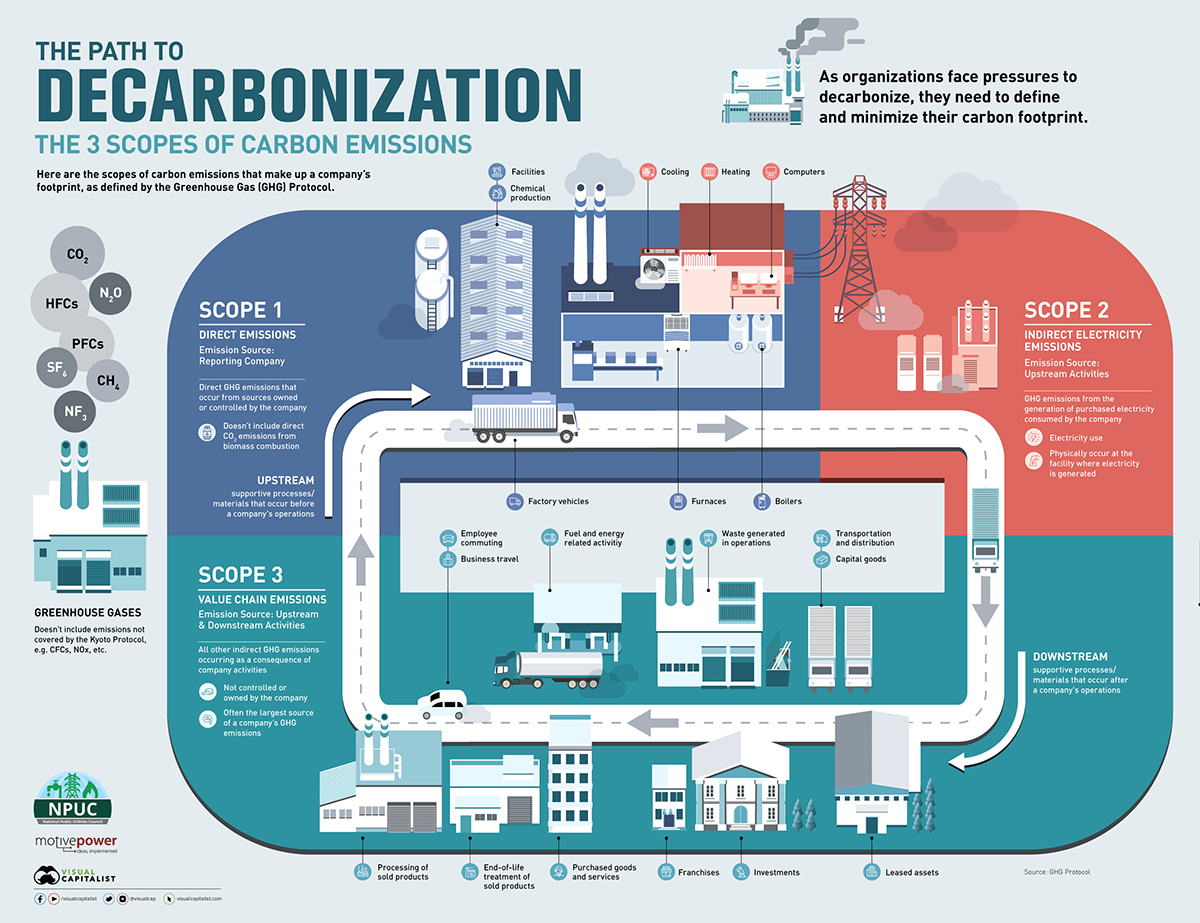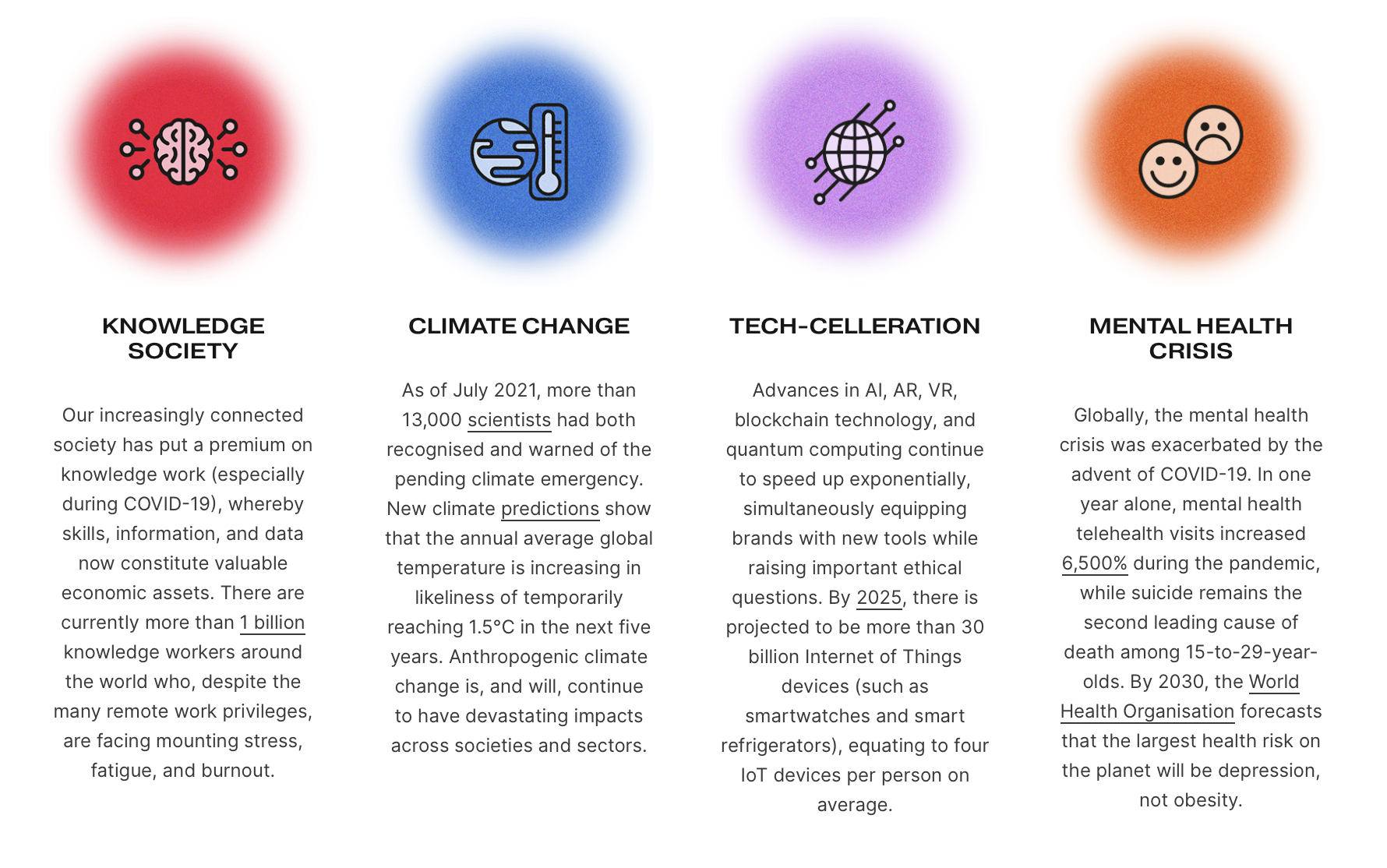AI will have a fundamental impact on every industry, and every economy, over the next decade, says a new report from ARK Invest
ARK’s Big Ideas 2024 report is entitled “Disrupting the Norm, Defining the Future” and it highlights 15 big ideas:
- Technological Convergence – The global equity market value associated with disruptive innovation could increase to 60% by 2030.
- Artificial Intelligence – Scaling global intelligence and redefining work: AI training costs should continue to fall 75% per year.
- Smart Contracts – Powering the internet-native financial system, smart contract networks could generate fees of $450bn in 2030.
- Digital Wallets – Digital wallets could grow select vertical software platforms’ revenues to $27-$50bn in 2030.
- Robotics – Generalizing automation, thanks to the convergence of AI software and hardware. Generalizable robotics represent a $24 trillion-plus global revenue opportunity.
- Digital Consumers – Transitioning toward digital leisure, where spending could teach $23 trillion in 2030.
- Electric Vehicles – Lower battery costs powering adoption mean EV sales could reach 74 million in 2030.
- Robotaxis – Robotaxi platforms could create $28 trillion in enterprise value in 2030.
- Multiomic Tools & Technology – Translating biological insights into economic value: R&D spending could decline by more than 25%, thanks to multiomic tools and technology.
- Reusable Rockets – Satellite connectivity revenues could exceed $130bn per year in 2030.
- Autonomous Logistics – Global autonomous delivery revenue could reach $900bn by 2030.
- Bitcoin Allocation – Growing the role of bitcoin in investment portfolios. During the last seven years, bitcoin’s annualized return has averaged around 44%.
- Bitcoin in 2023 – After challenges in 2022, bitcoin’s price surged 155% last year, reaching $827 billion in market cap.
- Precision Therapies – Curing disease more efficiently and less expensively. The enterprise value of companies focused on precision therapies could reach $4.5 trillion by 2030.
- 3D Printing – Revenues could grow 40% at an annual rate to $180bn by 2030.
The report believes that convergence among disruptive technologies will define this decade. Five major technology platforms—Artificial Intelligence, Public Blockchains, Multiomic Sequencing, Energy Storage, and Robotics—are coalescing and should transform global economic activity.

Technological convergence could create tectonic macroeconomic shifts more impactful than the first and second industrial revolutions. Globally, real economic growth could accelerate from 3% on average during the past 125 years to more than 7% during the next 7 years as robots reinvigorate manufacturing, robotaxis transform transportation, and artificial intelligence amplifies knowledge worker productivity.
Catalyzed by breakthroughs in artificial intelligence, the global equity market value associated with disruptive innovation could increase from 16% of the total* to more than 60% by 2030. As a result, the annualized equity return associated with disruptive innovation could exceed 40% during the next seven years, increasing its market capitalization from ~$19 trillion today to roughly $220 trillion by 2030.
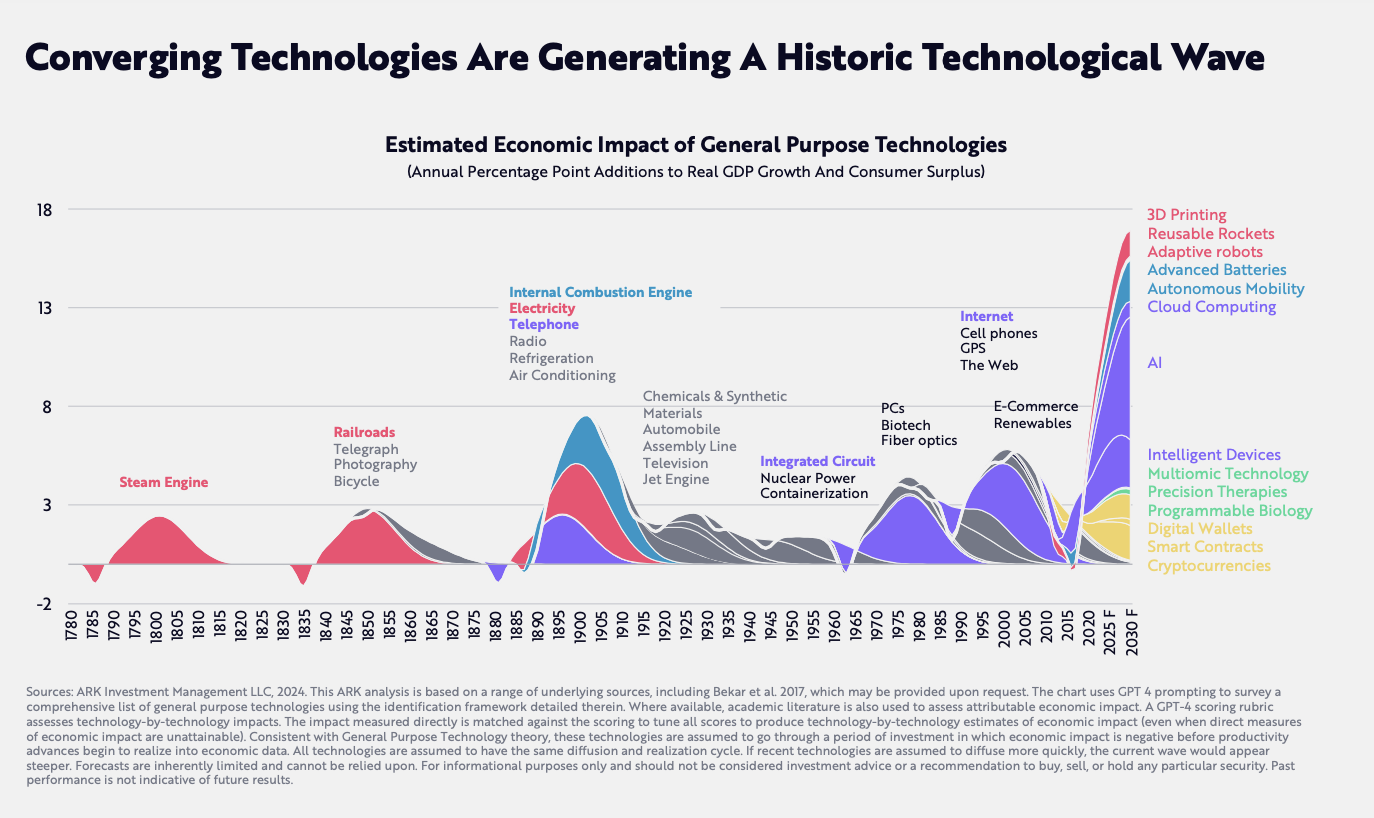
With superhuman performance on a wide range of tests, AI models like GPT-4 should catalyze an unprecedented boom in productivity. Jolted by ChatGPT’s “iPhone” like moment, enterprises are scrambling to harness the potential of artificial intelligence.
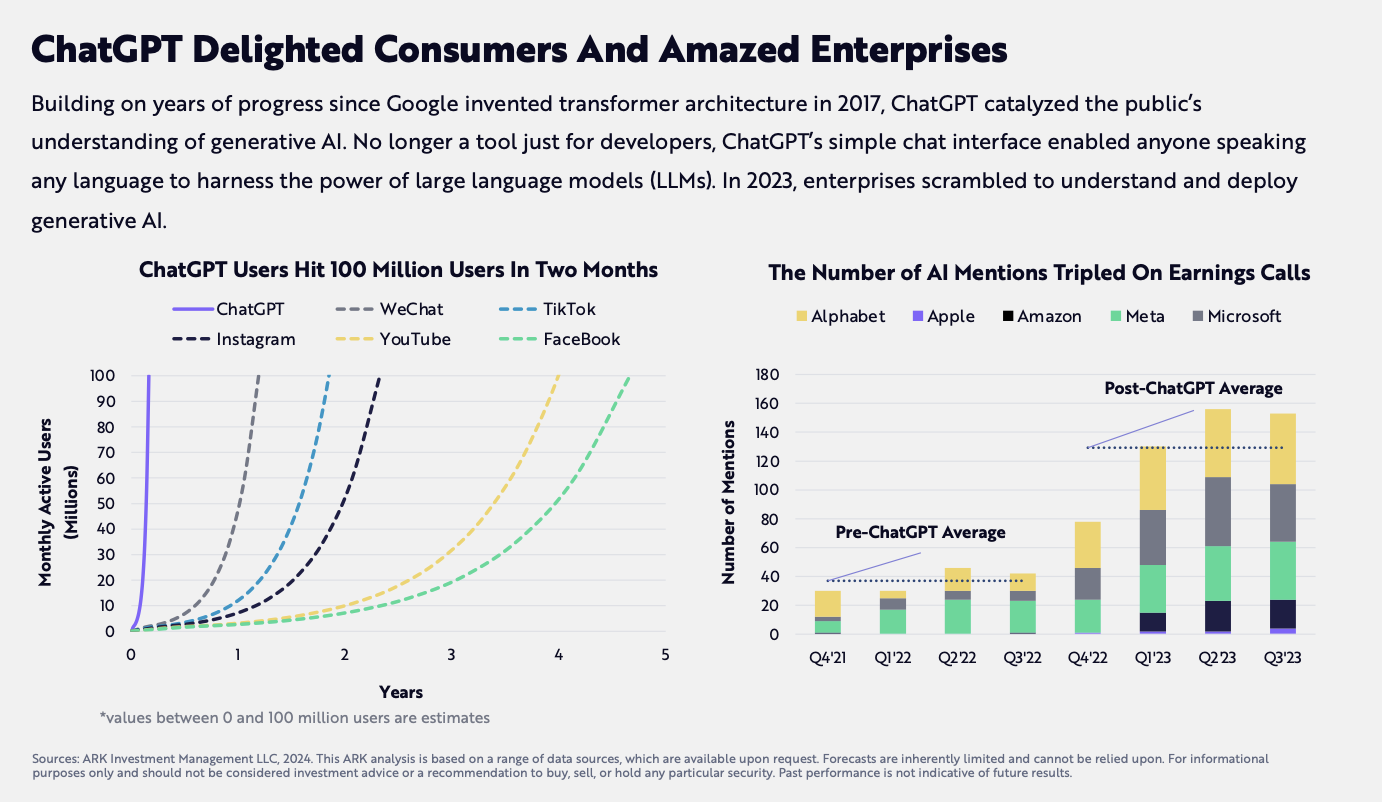
AI promises more than efficiency gains, thanks to rapidly falling costs and open- source models. If knowledge worker productivity were to quadruple by 2030, as we believe is likely, growth in real GDP could accelerate and break records during the next five to ten years.
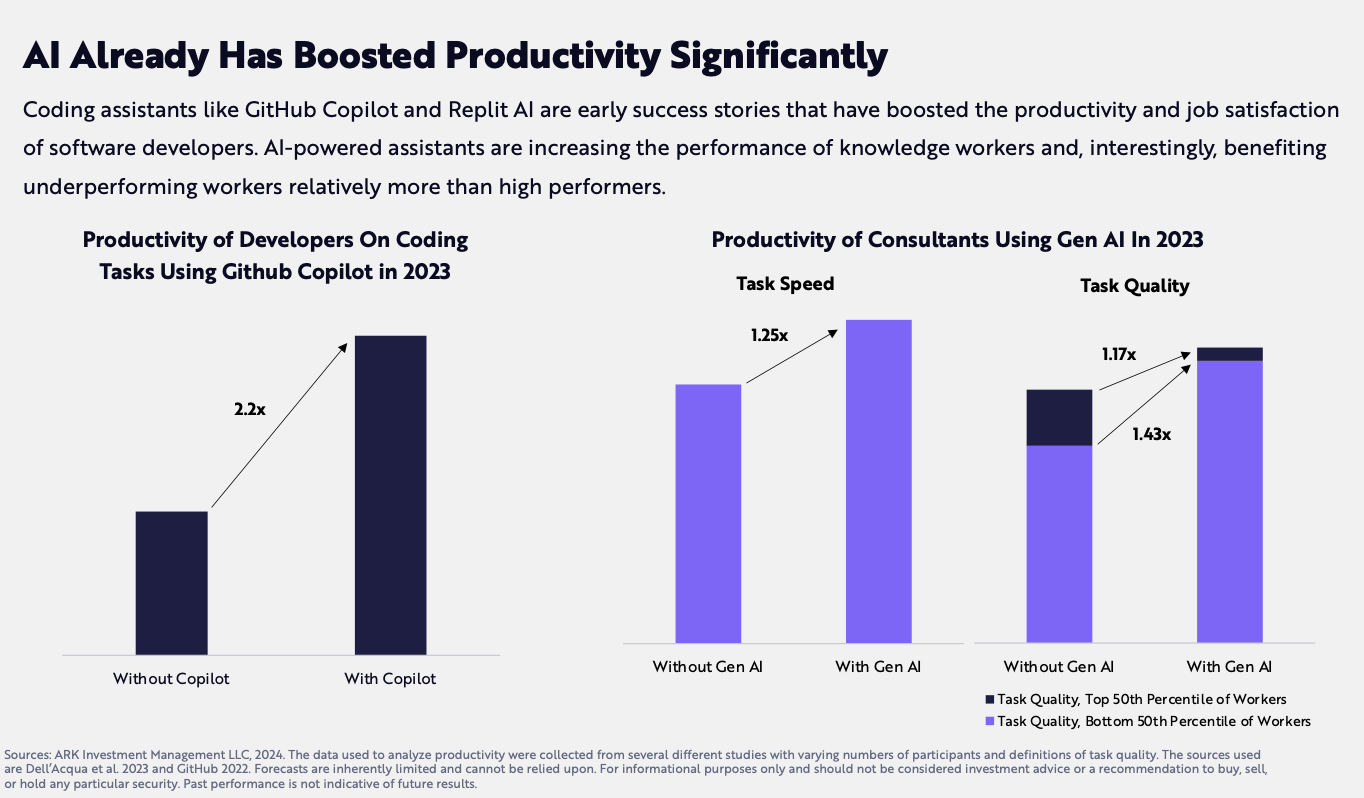
However the real impact of AI will be how it converges with other technologies to solve more fundamental challenges, and reinvent entire ways of operating. It becomes, as ARK calls it, the central technology catalyst:
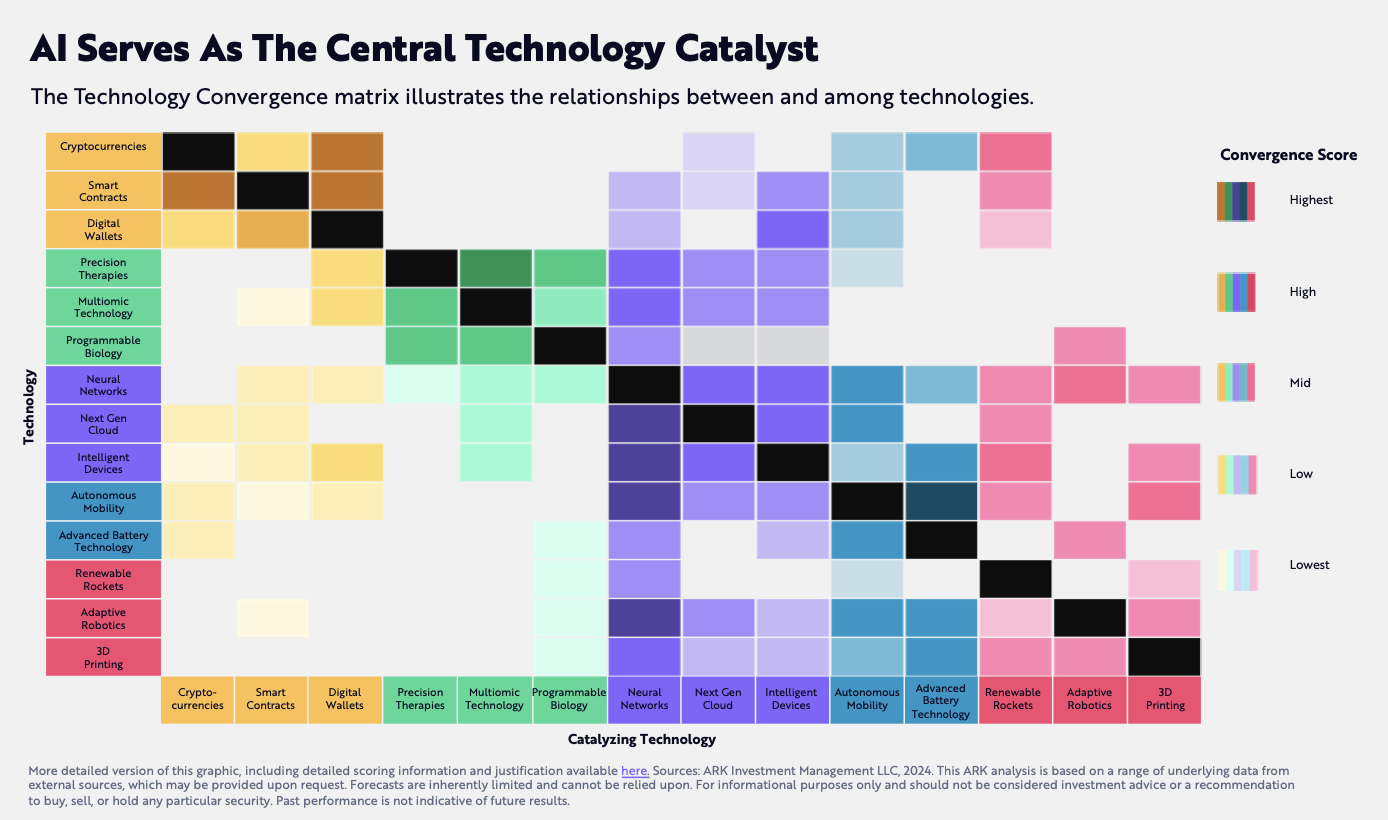
All this enthusiasm, adoption and investment is also accelerating the speed of development of AI, far faster than previously imagined. In particular ARK estimates that the advent of AGI, or general AI, where machines outsmart humans, is much closer than previously anticipated:
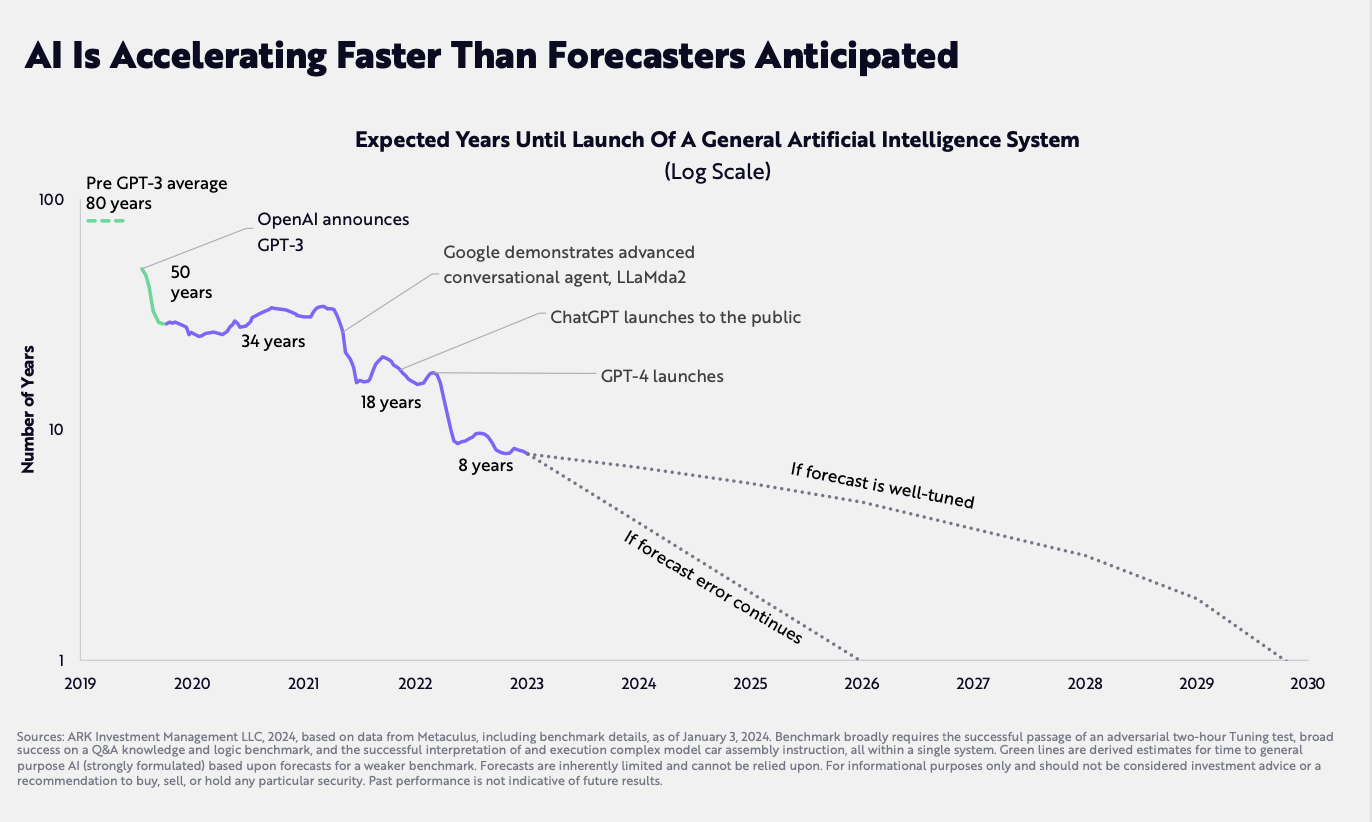
ARK is a Florida-based investment management company founded by Cathie Wood, who left her job as chief investment officer of Alliance Bernstein, because it felt her idea to build a fund based on disruptive innovation was too risky.
- 100 inspiring leaders by Peter Fisk
- Leadership trends 2024 by DDI
- Leadership assessment by Korn Ferry
- Strengths-based leadership by Gallup
- More on leadership from Peter Fisk
“What it Takes” is the memoir of Steve Schwarzman, cofounder and CEO of Blackstone, one of the world’s largest investment firms.
He talks about why leaders need clarity of purpose, to dare to think big, and realise the profound impact of AI. One of his favourite sayings is that “it is just as easy to do something big as it is to do something small”.
Schwarzman grew up in an entrepreneurial family selling curtains in Philadelphia. His father was content with owning one store, but Steve was not. He had more ambition. At high school he wanted to bring the best bands to play. At college he started a dance society to meet more girls. He joined Lehman as a trainee, where he learned about finance and discovered his real strength. In 1985 he co-founded Blackstone with friend Pete Peterson, and grew it to hold over $500 billion in assets under management.
He believes that leaders in today’s complex and uncertain world need clarity of purpose, to dare to think big, and realise the profound impact of AI, saying “it is just as easy to do something big as it is to do something small”.
He believes that successful leaders must have the confidence and courage to act when the moment seems right. They accept risk when others are cautious and take action when everyone else is frozen, but they do so smartly. This trait is the mark of a leader. “To be successful you have to put yourself in situations you have no right being in. You shake your head at your stupidity, but eventually it gives you what you want.”
Stepping up to lead
- “Leadership is lifting your vision to higher sights, raising your performance to a higher standard, building your personality beyond normal limitations” said Peter Drucker
- “Change will not come if we wait for somebody else, or some other time. We are the ones we’ve been waiting for. We are the change that we seek” said Barack Obama
- “Don’t be intimidated by what you don’t know. That can be your greatest strength and ensure that you do things differently from everyone else”said Sara Blakely
- “Great entrepreneurial DNA is comprised of leadership, technological vision, frugality, and the desire to succeed” said Steve Blank
- “Courage is not the absence of fear, but the triumph over it. The brave man is not he who does not feel afraid, but he who conquers that fear” said Nelson Mandela
- “People will forget what you said, people will forget what you did, but people will never forget how you made them feel” said Maya Angelou
- “Your time is limited, so don’t waste it living someone else’s life … Have the courage to follow your heart and intuition” said Steve Jobs
- “Never give up. Today is hard, tomorrow will be worse, but the day after tomorrow will be sunshine” said Jack Ma
What is leadership?
3.5 billion people will make up the global workforce by 2030, around half of who are likely to be self-employed. If we assume that in organisations people typically work in teams of around 10 people, then there will be around 220 million leaders in organisations over the next decade, plus many more who lead in virtual and collaborative ways.
However most surveys say that leaders are struggling. The majority of employees believe that they can do their jobs as well, or if not better, without their supervisors and managers (80% in one Gallup study). Only 15% of people feel truly engaged in their work, and many say that managers are one of their main reasons for leaving jobs.
“Managing”, of course, is not the same thing as “leading”. Managing is typically described as using controls to achieve a task. Leading is about influencing, motivating and enabling people to contribute, and achieve more. Managers do things right, leaders do the right things. Managers focus on methods to achieve efficiency, leaders focus on purpose to achieve effectiveness. Or managers have their heads down, leaders have their heads up.
Anyone in the organisation can be a leader. Not everyone in the business is a manager, although managers need to be leaders.
Not everyone is born a leader, but anyone can become one.
Leadership is your choice, not something which is given to you. Leadership is not a job title, a position of authority, or a magical gift. It starts with having confidence. Having a vision that you believe in. Having the courage to step forwards. Engaging other people. And yourself, being the change you want to see in others.
- “I think the fundamental role of a leader is to look for ways to shape the decades ahead, not just react to the present, and to help others accept the discomfort of disruptions to the status quo” says Indra Nooyi, former chairman and CEO of PepsiCo
- “Leaders of other enterprises often define themselves as captains of the ship, but I think I’m more the ship’s architect or designer. That’s different from a captain’s role, in which the route is often fixed and the destination defined” reflects Zhang Ruimin, founder and former CEO of Haier
- “The single most important thing I have to do as CEO is ensure that our brand continues to be relevant.” adds Chris Kempczinski, CEO of McDonald’s
- “I think my leadership style can be called ‘collaborative command.’ You bring different opinions into the room, you allow for a really great debate, but you understand that, at the end of the day, a decision has to be made quickly” says Adena Friedman, CEO of Nasdaq
- “We need an urgent refoundation of business and capitalism around purpose and humanity. To find new ways for all of us to lead so that we can create a better future, a more sustainable future” concludes Hubert Joly, former chairman and CEO of Best Buy.
Leaders shape the future
When writing “The Complete CEO” we found that very few CEOs could actually define leadership. They were comfortable describing their positions in organisation hierarchies, and the defined responsibilities of their roles, but few were able to say what it meant “to lead”. Eventually I got words about inspiration and influence, vision and direction, followership and alignment, but quite inconsistently.
Marissa Mayer, the previous CEO of Yahoo!, defines leadership as “helping believe in a better tomorrow, with a better outcome than you have today”.
DDI’s “Global Leadership Forecast” report says that only 42% of leaders felt that the overall quality of leadership inside their organisations was high, and only 14% of leaders felt they had a strong “bench” of next generation leaders ready to step up. Most sports teams have at least double their first team squad, as reserves ready to step up if required. Another DDI report on leadership development in 2015 said that 71% of organisations said their leaders are not ready to lead their organisations into the future.
Dave Ulrich sought to bring together all the best leadership theories, models and competencies in “The Leadership Code” and summarising leadership as five overarching roles:
- Strategist: Leaders shape the future
- Executor: Leaders make things happen
- Talent manager: Leaders engage today’s talent
- Human capital developer: Leaders build the next generation
- Personal proficiency: Leaders invest in their own development
I know Ulrich quite well. He even took off his tie and gave it to me, whilst we were once on stage together in Istanbul. He is probably one of the most business-oriented leadership experts around, and much of his personal work is in connecting leaders to strategy, and their impact to value creation. Yet he says himself, too many leadership ideas, and the development of leaders, is done in a vacuum, as a separate skill.
So whilst most leadership thinking tends to focus on the leadership role in the context of leading people, teams and organisation – which of course, matters – Ulrich rightly argues that the most important question a leader needs to answer is “Where are we going?”
In today’s world, organisations need leaders, more than ever, to look forwards.
Leaders don’t have to be strategists in the traditional sense of spending many hours analysing markets, developing rigorous plans supported by lots of commentary and financial projections. The strategic contribution of a leaders needs to be context setting – defining a clear purpose, envisioning what the future will look like, stretching mindsets of what is possible, articulating the ambitions, the big choices, and horizons to aim for.
Business performance is the measure of how well leaders do this. Warren Buffett will of course remind us that a CEO of a public company is legally responsible to deliver a return to shareholders, but he would also agree that this is more an outcome. Value creation is the framework to engage all stakeholders in progress. The challenge for leaders is not to become obsessed by financials, but to define purpose and be the moral compass of the organisation, to achieve more, in a better way.
Leaders earn their power from how they inspire people with ideas, influence people about what’s right, and the impact they have through their actions. This is quite different from the old power of leaders, which came through position, experience and expertise. Instead of leadership based on command and control, I see a leaders as a
- Catalyst: the leader stimulates and stretches the organisation, asking the important questions, adding energy and urgency, focusing on insights and goals.
- Communicator: the leader articulates purpose, vision and direction, listening and engaging with people, building empathy and trust, creating a better future together.
- Connectors: the leader connects ideas, people, activities and partners; encouraging learning and collaboration; facilitating new capacity for innovation.
- Coaches: the leader supports rather than commands; to think, act and deliver better; and encouraging them have the confidence to rise up.
I also love the definition of leaders as “amplifiers” – they amplify the potential of people. And equally of organisations and all their stakeholders. They open up new spaces to go for, and through inspiration and influence, they create a belief and confidence that it is attainable. Amplifying is about increasing the capacity to succeed, and therefore about transforming your potential, personally and organisationally.
Leaders with purpose
Danone is an organisation driven by a sense of purpose to create a healthier society, a responsibility to all stakeholders and a “B Corporation” priority for sustainability. As a result, the “how” matters as much as the “what” in what the business does, but also how its leaders lead, saying that breakthrough results can only be achieved when people dare to express and demonstrate their leadership potential.
Danone describes its unique style of leadership using “CODES”, the behaviours which bring its values and beliefs to life. These five behaviours shape everything in its culture, from recruitment to development, performance and rewards:
- C … Create a meaningful future: challenge the status quo and generate breakthrough ideas, every day can be a fresh adventure, full of new possibilities and real excitement, demanding a sense of purpose for yourself, team and colleagues.
- O … Open connections inside and out: open to new thinking and fresh perspective, developing networks inside and outside, interacting at all levels and building trust to understand all stakeholders, and design products of the future.
- D … Drive for sustainable results: a culture of speed and agility, where individuals are free and express their talents, anticipating and driving progress in a way that sustains value creation for the business, consumers and the community.
- E … Empower yourself and diverse teams: leadership not micromanagement, releasing the power of the team with the right mix of support and freedom, enabling people to express their uniqueness and foster collective performance.
- S … Self-aware: being aware of your own strengths and development needs is essential to learn and grow, maintaining self-balance at work by recognising when to step back and when to reach out to others.
Quiet leaders, inspiring leaders
Pablo Isla, CEO of Inditex, is the humble Spanish king of fast fashion. Quiet and unassuming, like a sports coach he sees the power in his team, and his job is to make them the stars.
On first meeting, Isla might not strike you as one of the world’s leading CEOs. He is quiet and unassuming, but as leader of Spanish fashion monolith, Inditex, that is his strength. During his 12 years at Inditex, with brands from Zara to Mango, he has increased enterprise value seven times over, engaged in global expansion at a rate of on average one new store opening a day, and has made Inditex Spain’s most valuable company.
Isla’s priorities have been about achieving greater integration and efficiency. Firstly, creating an omnichannel shopping experience, that combines the best of aspects of technology and stores. Secondly, an integrated supply chain, able to quickly react to changing fashion.
The single word which most employees use to describe his style is humble. He seeks to avoid any form of hierarchy, he hates meetings, and despises ego. Instead he likes to make decisions informally as he walks around. He even avoids his own store openings, wanting the focus to be on the store and his teams.
“The strength of our company is the combination of everybody, much more than of any single person. We try to be a low-profile company, being humble, of course being very ambitious, but being humble” he told Harvard Business Review
“The core shopper dreaming of a $50 pair of affordable but high-fashion high heels from Zara wants to hear about the new store in her neighbourhood, not about how in control some privileged executive is.” Of all his staff, he highlights the role of front-line store managers who are empowered to make product selections and who he sees as the people who he is there to serve
Growing as a leader
As leaders progress in the organisation their roles changes, from technical to functional, tactical to strategic, management and leadership. With these role come changing perspectives and responsibilities:
- Short term to long term
- Transactional to transformational
- Functional expert to organisational
- Managing tasks to managing porfolios
- Limited stakeholders to multiple stakeholders
- Getting the job done to optimising value creation
Whilst we might think of leadership as one approach, the styles of leadership are different as we progress in an organisation. The “six passages” of leadership was developed by Walter Mahler in the 1970s, based on leadership behaviours and successions in GE, and focuses on the “critical crossroads” that leaders face during their career.
Here are the 7 “levels” of leadership, and the 6 “passages” or transitions from one stage to the next, and the change in skills and mindsets which the transition demands:
- Leading self: individual contributors, professional staff, driven by tasks and expertise, establishing credibility, delivering results.
>>> Transition 1: from skills to collaboration, from doing work to getting it done
- Leading others: leaders of small teams or projects, recruiting and developing, resolving conflicts, delegating, adapting to cultural differences.
>>> Transition 2: from personal to team agendas, from organising to coaching
- Leading managers: leaders integrate teams, managing trade-offs and politics, problem solving, negotiating and risk taking, engaging people.
>>> Transition 3: from activities to functional strategies, from tasks to complexity
- Functional leaders: aligning resources, developing leading practices, driving and implementing change and innovation, managing dispersed teams.
>>> Transition 4: from current to future thinking, from costs centres to profit centres
- Business leaders: developing vision, balancing short and long-term, aligning with organisation, working across functions, exploring new business models.
>>> Transition 5: from managing business, to a strategic portfolio of businesses
- Group leaders: managing performance across businesses, for today and tomorrow, catalysts of change and innovation, exploring new ventures and renewal.
>>> Transition 6: from internal to external stakeholders, managing whole systems
- Enterprise leaders: top executives, engage all stakeholders, set direction and build leadership team for today and future, shape culture and reputation.
In time, leaders assume greater responsibility, and leadership roles increase in their challenge, breadth, and complexity. As leaders advance, they reallocate their focus to help others to perform effectively. They learn to value the work of leadership and believe that making time for others, planning, coordinating, and coaching are imperative in their new responsibility.
One way to consider the evolution is as a “T” shape, moving up the vertical when roles are largely built around function, to the horizontal where are role are much broader and cross-functional. As the leader moves from an area of expertise to general management, they shift from needing to have all the answers, to being able to ask the right questions.
Of course, many leadership attributes, such as accountability, engagement and delivery – are common at all stages although executed in different ways. Also as organisations shift from tall hierarchies to flatter networks, then there are less stages of leadership, from seven to maybe only three.
What’s your best leadership style?
We all tend to have a preferred or “natural style” of leadership.
Leading in a way that feels right and natural to you, is both easier for you, and more consistent and authentic for others. Whatever your style, people will engage with and trust you more, if they know that you are genuine.
At times though you may need to adapt your style, or embrace aspects of other styles for a specific purpose. Daniel Ek, CEO of Spotify, for example, found that he was too laid back for his teams when they were looking for direction and focus. He worked on making the most of his own style, while strengthening aspects that met the needs of his teams.
There are many theoretical models of leadership to take ideas from.
Kurt Lewin classified leadership styles into autocratic, participative and laissez-faire. Tannenbaum and Schmidt saw leadership as a continuum of styles, ranging from autocratic to freed, but said that the best style at any time depended upon a variety of factors, such as the leader’s personality and the situation they faced. Daniel Goleman, who coined the phrase “emotional intelligence” developed a framework of six different styles built on a leaders ability to emotionally engage with people in different ways – visionary, coaching, democratic, pacesetting, affiliative and commanding.
Here are some of the different approaches, grouped by their objectives:
Leading in an inspiring style … when you want to encourage people to work with you in creating a better future, providing energy and direction to move forwards:
- Transformational … “Imagine if “… opportunity to grow, yourself and business
- Visionary … “Come with me” … a new direction, empathetic, builds confidence
- Pacesetting … “We can do this” … driven to achieve, energising but exhausting
Leading in an nurturing style … when you want to support people to be their best, although not necessarily about thinking about being creative or moving forwards:
- Servant … “Here for you” … secures resources so that people can act as see fit
- Coaching … “Try this” … empathy, supports individual needs, but less directive
- Affiliative … “People come first” … empathy, reassures and builds the team
Leading in a more engaged style … when you want to let people get on with their work, trusting that they have capabilities and desire to do the task:
- Laissez-faire … “Do what you think” … entrusting people to deliver, giving space
- Transactional … “You know what to do” … clear tasks, intervene if not delivered
- Bureaucratic … “Follow the process” … clearly defined technical steps to follow
Leading in a commanding style … when you want to be in charge and make the decisions, often when you believe people don’t have the capabilities to decide:
- Consultative … “Tell me what you think” … you listen and then decide yourself
- Persuasive … “This is what, and why” … you decide then seek to persuade them
- Autocratic … “Do what I tell you” … demotivating but can work in crisis
Knowing when and how to adapt your leadership style to different situations can have a huge impact on how your team will respond. For example if you are trying to build capabilities within your team you may find that the coaching leadership style works best. If you have urgent deadlines, then pacesetting. If you need to be highly structured and compliant, the bureaucratic. If you want people to work together to create a better future for all, then transformational.
Evaluating leaders
Korn Ferry, the search firm, developed a particularly useful assessment model for leadership development, in order to identify how ready and able individuals are to move to the next levels of leadership. They organise the qualities required in leaders into four distinct categories. Each dimension plays a distinct role in performance, engagement, potential, and personal career development:
- Drivers and Traits, which describe “who you are” … drivers are the values and interests that motivate a person, traits are the natural tendencies of a person, influenced by personality and intelligence.
- Experiences and Competencies, which describe “what you do” … experiences are projects or roles that can prepare a person for a future role, competences are the observable skills and behaviours.
Most organisations regard an individual’s “drive” as a key predictor of high potential, meaning their level of personal energy and engagement they have for their tasks. At the same time, people are more energised by roles that have a good fit with them. Leaders typically want to be leaders, they find the role of a leader interesting and the work of leading motivating. This is particularly tested as they have to allocate more time to leadership aspects of roles as they progress.
Traits also play a large role in how people develop, defining what is more natural for them and what is more of an effort. Traits endure over time, and exert a strong influence on a person’s outlook, attitudes and behaviours. Traditionally personality inventories, based on traits, have been the primary diagnostic tool for leaders.
Korn Ferry’s leadership potential model embraces these factors, and evaluates how a person will progress through the different levels of leadership, and the transitions required:
- Drivers
- Advancement drive: through collaboration, ambition, challenge.
- Career planning: how narrowly or broadly focused are career goals
- Role preferences: achieving through others vs. through self.
- Experience
- Core experience: what they’ve learned through day-to-day leadership.
- Perspective: diversity of experience in many different areas.
- Key challenges: their experience in addressing developmental challenges.
- Awareness
- Self-awareness: of their strengths and development needs.
- Situational self-awareness: how events impact their performance.
- Learning agility
- Mental agility: to be inquisitive and mentally quick.
- People agility: to read others and use this to enable change.
- Change agility: to explore new possibilities, take ideas from vision to reality.
- Results agility: to deliver outstanding results in new and tough situations.
- Leadership traits
- Focus: the balance between details and the big picture.
- Persistence: the passionate pursuit of personally valued long-term goals.
- Tolerance of ambiguity: to deal with uncertainty or confusing situations.
- Assertiveness: willingness to assume a leader role and comfort with it.
- Optimism: to have a positive outlook.
- Capacity
- Problem solving: spot trends and patterns and draw correct conclusions from confusing or ambiguous data.
- Derailment risks
- Volatile: a risk toward being mercurial, erratic, or unpredictable.
- Micromanaging: a risk toward controlling the work of direct reports.
- Closed: a risk of being closed to alternative perspectives and opportunities.
Ultimately your leadership is not measured by what you do, but the impact you have. The way you can positively effect your people, the way in which they drive the activities of organisation, and what it achieves.
IE Business School, based in Madrid, is just down the road from the Santiago Bernebéu stadium, the home of Real Madrid, the Spanish football club who are Europe’s all-time most successful soccer team.
I always take the business leaders who I teach at IE, to the stadium as part of my programs. We walk past the showcases of trophies, the photos of past successes, through the changing rooms, and out into the cauldron of competition where 80,000 fanatical spectators usually look down on the game.
I beckon them to sit down on the bench, the seats reserved for the coach and his staff, at the side of the pitch. For a few minutes they can be Zinadine Zidane, or whoever the coach is. He has spent hours on the training field with his players, sharpening fitness and skills, talking strategies and tactics, preparing for the competition. But once the match begins, his players are on their own. he entrusts all to his players. They now need to respond to whatever happens, to make their own decisions in the heat of competition. His own success is 100% entrusted in his team.
Whilst the coach can perfect his own leadership skills, how he uses them to influence others is what matters. His own success is entrusted in his people.
© Peter Fisk 2024. Excerpt from Business Recoded by Peter Fisk
Green cement, upcycled fashion, clean energy, plant-based food, electric vehicles … the challenge of decarbonisation is the catalyst to innovate solutions, and reinvent organisations.
Across industries and geographies, the urgency to achieve “net zero” is dominating corporate strategies, as we as sustainability agendas. It has become a key factor in driving competitive advantage (customers choosing suppliers who can help them reduce their own emissions), as well as employee engagement, investor perceptions, government and social goodwill, and ultimately value creation.
Sustainable businesses do better – overall they typically outperform average performers by 42% in market value. But they also attract the best talent, customers are likely to pay a premium of 10-25% depending on sector, investors take a more positive view of future potential, and government and social support are much greater.
While the focus is on carbon emissions, there is much more to achieving success:
- Sustainably Better is much more than ESG, as strategies are much than metrics, and environmental issues are just part of the story. Environmental protection, social improvement and economic growth need to work together. Otherwise the emerging economies will never support it, and generally we will have unsustainable compromise rather than sustainable growth, value creation and a better future.
- Net Positive rather than just net zero, because ultimately an organisation exists to make a contribution, to make some net positive benefit to the world. And in many cases the best strategies combine reduced environmental impacts, with positive social impacts. Or indeed, the environmental impacts could be positive too through closed loop solutions, replenishing resources, and regenerating the planet, and local environments, to better than before.
- Sustainable Innovation is the real key to solving the problem, or more precisely sustainable innovation – using the problem, for example, carbon emissions, as the catalyst to create something better, cheaper, faster. There is no coincidence that electric vehicles tend to be the most stylish, and increasingly highest performing, too. New technologies will play a dramatic, exponential role in unlocking this innovativeness.
- Business Transformation is required to address these challenges and opportunities. Circular, net positive, organisations are only achievable with the support of new business models, new organisation processes and new market structures of today. Transformation is the leadership superpower of the 21st century, but it is complex, and takes time. It needs clarity of vision, discipline in delivery, and persistence to realise its full value.
Which are the critical industries for decarbonisation?
- Energy: Over the past decade, the costs of renewables have dropped substantially—solar power by as much as 80% and wind power by about 40% —making them economically competitive with conventional fuels, such as coal and natural gas. A successful transition to net zero will require meeting increased demand for electricity by scaling up renewable, low-carbon power generation and building enough flexibility in power systems to match supply and demand.
- Cars and Planes: Sales and planned production of low-emissions cars have surged. By 2035, we project that new passenger-vehicle sales in the largest automotive markets (China, EU, and USA) will be close to 100 percent electric. To make low-emissions vehicles the new norm, new supply chains and manufacturing capabilities are needed, as well as corresponding infrastructure, such as charging stations and hydrogen fuelling stations.
- Cement and Steel: Some cement companies have used advanced analytics and other operational tactics to optimise for energy efficiency, while others have experimented with emissions-reducing production methods. A circular model starts with existing materials, creating new buildings from old waste. Going forward, the industry could explore alternative energy sources (such as biomass), carbon capture, and digitisation of manufacturing.
- Agriculture and Food: Promising technologies in animal feeding, soil carbon sequestration, and crop fertilisation are in development or are already in use. The market for cultivated meats—those grown in bioreactors from animal cells—could become a $25 billion global industry by 2030. Uptake of zero-emissions farm equipment and machinery—including tractors, harvesters, and dryers—is behind that of electric vehicles, but cost reductions and supportive financing could accelerate adoption.
What does the Paris Agreement demand?
The UN Climate Change “Paris Agreement” is a shared commitment by 196 nations at COP21, head in Paris in 2015. It sets the stage for global climate action, emphasizing the urgency of reducing emissions and transitioning toward a sustainable, low-carbon future. Key points are:
- Limiting global warming by holding “the increase in the global average temperature to well below 2°C above pre-industrial levels” and pursuing efforts to limit it to 1.5°C above, which is the point beyond which significant climate impacts are caused, including droughts, heatwaves, and extreme rainfall.
- Reducing greenhouse gas emissions by 43% by 2030, after a projected peak in 2025, to achieve the 1.5°C goal, with each country developing their own Nationally Determined Contributions (NDCs) defining their actions to reduce emissions and build resilience to climate change.
- Achieving net-zero emissions by 2050, where “net zero” means balancing emissions by absorbing an equivalent amount from the atmosphere. The agreement recognises that this is a shared commitment, and will require cooperation between nations to achieve it, sharing knowledge and practices, and collaboration on new the transformations required.
That’s the absolute minimum, to retain our world as we know it, which is the focus of politicians and environmentalists. But as business we need to achieve much more. Delivering the Paris Agreement in a way that also creates a better business, with a more prosperous future – which is why sustainably better, net positive, sustainable innovation and business transformation, are key.
So what are the practical strategies?
The most commonly used breakdown of a company’s carbon emissions are the three scopes defined by the Greenhouse Gas Protocol, a partnership between the World Resources Institute and World Business Council for Sustainable Development.
The GHG Protocol separates carbon emissions into three buckets: emissions caused directly by the company, emissions caused by the company’s consumption of electricity, and emissions caused by activities in a company’s value chain.
- Scope 1: Direct emissions: these emissions are direct GHG emissions that occur from sources owned or controlled by the company, and are generally the easiest to track and change. Scope 1 emissions include factories, offices, vehicles, production.
- Scope 2: Indirect electricity emissions: These emissions are indirect GHG emissions from the generation of purchased electricity consumed by the company, which requires tracking both your company’s energy consumption and the relevant electrical output type and emissions from the supplying utility. They include electricity use (e.g. lights, computers, machinery, heating, steam, cooling) and emissions occur at the facility where electricity is generated.
- Scope 3: Value chain emissions: These emissions include all other indirect GHG emissions occurring as a consequence of a company’s activities both upstream and downstream. They aren’t controlled or owned by the company, and many reporting bodies consider them optional to track, but they are often the largest source of a company’s carbon footprint and can be impacted in many different ways. This include supplies, investments, employee travel, company waste.
Most uses of the GHG Protocol by companies includes many of the most common and impactful greenhouse gases that were covered by the UN’s 1997 Kyoto Protocol. These include carbon dioxide, methane, and nitrous oxide, as well as other gases and carbon-based compounds.But the standard doesn’t include other emissions that either act as minor greenhouse gases or are harmful to other aspects of life, such as general pollutants or ozone depletion.
There are many different types of carbon emissions for companies (and governments) to consider, measure, and reduce on the path to decarbonisation. But that means there are also many places to start.
Practical examples
Cities are a major arena in the race to net zero. They consume over two-thirds of global energy resources and account for more than 70% of CO2 emissions worldwide.1More than half (56%) of the global population currently lives in an urban area. The UN expects that number to reach 68% by 2050.
New research by Economist Impact, supported by Osborne Clarke, identifies some of the technologies that can help cities achieve their carbon-emission targets while also creating jobs, lowering energy costs for residents, and improving overall quality of life. It considers three categories of technologies – support building, infrastructure and mobility.
The UN Environment Programme (2017) reported that buildings and construction are responsible for over 36% of global energy consumed, and as much as 40% of energy-related CO2 emissions. Technologies in this sector help increase the energy efficiency of existing buildings, while also reducing the carbon footprint of the construction sector as a whole.
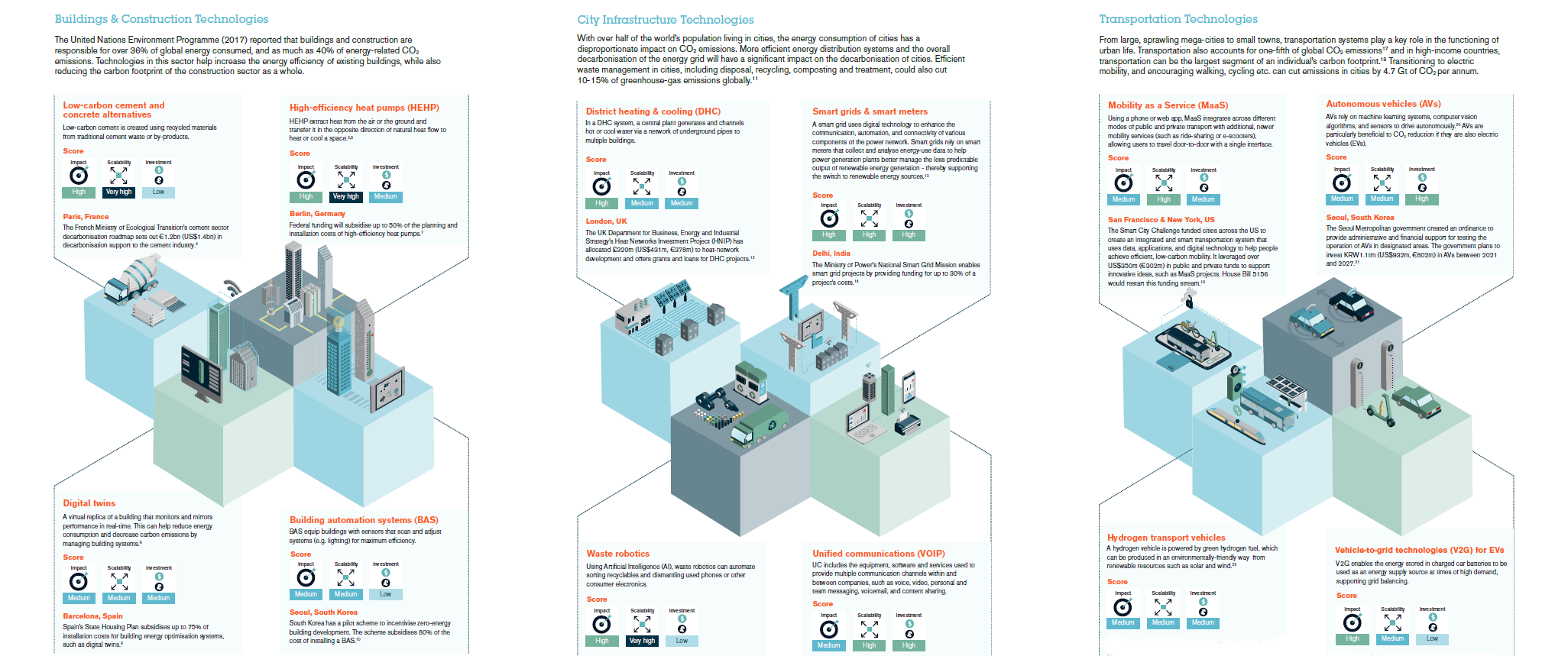
The energy consumption of cities has a disproportionate impact on CO2 emissions. More efficient energy distribution systems and the overall decarbonisation of the energy grid will have a significant impact on the decarbonisation of cities. Efficient waste management in cities, including disposal, recycling, composting and treatment, could also cut 10-15% of greenhouse-gas emissions globally.
From large, sprawling mega-cities to small towns, transportation systems play a key role in the functioning of urban life. Transportation also accounts for one-fifth of global CO2 emissions17 and in high-income countries, transportation can be the largest segment of an individual’s carbon footprint.18 Transitioning to electric mobility, and encouraging walking, cycling etc. can cut emissions in cities by 4.7 Gt of CO2 per annum.
In the 1400s, Leonardo da Vinci designed a complex mechanical robot clad in a suit of armour, capable of sitting, standing, and independently moving its arms. The entire robot was operated by a system of pulleys and cables. In the 17th to 19th centuries, the Japanese built humanoid automata called karakuri puppets. These puppets resembled dolls and were used for entertainment in theatre, homes, and religious festivals.
Sci-fi movies have captured our imaginations with the cute human-like possibilities of machines – from the tin woodman in 1930’s The Wizard of Oz, to droid friends C-3PO and R2-D2 in Star Wars of 1977.
Real world examples of humanoid robots have included Honda’s Asimo, which was launched in 2000 to demonstrate new technological advancements of intelligent machines. And in 2016 Sophia, a humanoid robot developed by Hanson Robotics in Hong Kong was physically modelled on Audrey Hepburn, adding artificial intelligence, visual data processing and facial recognition.
AI-enabled robots
The prospects for machines that help with everything from serving coffee to folding laundry, carrying boxes in warehouses to handling hazardous waste, caring for the elderly to fighting on the battlefield, have improved as progress in AI accelerates and investment in humanoid robots grows faster than anticipated.
“Humanoids” are advanced robotic machines capable of emulating human actions, reasoning, and operations. They represent the convergence of technologies like AI, biomechanics, machine learning, and sensor connectivity with learning, cognitive development, and behavioral studies. Humanoids are crafted to mimic the human shape, aligning with the human-centric design of our world, from tools to building to homes.
The worldwide market for humanoid robots is forecast to be bigger than analysts in Goldman Sachs Research expected even a year ago, are currently having most impact logistics, manufacturing, healthcare and hospitality, but their use is still limited, and development costs are high. The total addressable market is projected to reach $38 billion by 2035.
Supporting this accelerated growth, the manufacturing cost of humanoid robots has dropped from a range that ran between an estimated $50,000 (for lower-end models) and $250,000 (for state-of-the art versions) per unit last year, to a range of between $30,000 and $150,000 now.
Robot Makers
Prominent companies driving the humanoid robotics field include established players like Boston Dynamics, Tesla, and Toyota, and startups like Agility Robotics and Figure, with each company bringing a distinct focus.

Boston Dynamics’s Atlas, its most advanced humanoid robot, launched in 2013 as part of the DARPA Robotics Challenge, has recently been updated it with an all-electric version. With its bipedal agility, human-like movement, autonomous navigation, and robust learning abilities, Atlas has gained widespread industry acclaim and has become an internet sensation. Atlas features whole-body skills for swift, dynamic movements, allowing it to lift and carry objects, perform complex exercises like jumping and backflips, and participate in disaster response and industrial tasks that demand dexterity and adaptability.
Tesla’s Optimus Gen 2, is in development for commercial purposes. It is a versatile, general-purpose machine capable of assisting in multiple domains, including manufacturing, construction, healthcare, and entertainment. The robot offers precise, flexible movement capabilities, and its hands, equipped with 11 degrees of freedom, feature tactile sensors and high-speed actuators, enhancing its object manipulation skills. Optimus runs on the same neural networks powering Tesla’s cars, and the company’s expertise in battery technology, sensing, and computing is expected to allow it to operate more cost-effectively than competitors. CEO Elon Musk stated that the prototype could cost only $20,000 upon launch.
Agility Robotics’s Digit the first human-centric, multi-purpose robot made for logistics work has been adopted by Amazon. Digit is designed from the ground up to go where people go and do useful work safely in spaces designed for people, starting with bulk material handling within warehouses and distribution centers. Digit’s “backward” legs unlock the ability to maneuver in tight spaces and get closer to shelves, conveyors, and other infrastructure. The unique design also allows Digit to reach deeper and maintain an operational pick range from the floor all the way up to nearly 6 feet.
Figure AI’s 01 has demonstrated the first fruit of its collaboration with OpenAI to enhance the capabilities of humanoid robots, conversing in real-time. Figure AI raised $675 million from investors including Jeff Bezos, Nvidia, Microsoft and OpenAI. Founded in 2022, it has developed a general-purpose robot, called Figure 01, that looks and moves like a human. The robot, attached to a tether, walks on two legs, and uses its five-fingered hands to pick up a plastic crate, then walks several more steps before placing the box on a conveyor belt.
Engineered Arts’s Ameca, has a silicon face and is equipped with sensors that can track a person or object’s movement. It’s able to express astonishment and surprise, and can recognise faces and voices. Ameca also yawns and shrugs, and can discern emotions and even age. It can also shush you if you’re being too loud. Engineered Arts is based in Cornwall, southwest England. Ameca is currently associated with UAE’s Museum of the Future’s robotic family in Dubai, where it can interact with visitors.
Nvidia’s Project GROOT has developed an innovative general-purpose foundation model specifically designed for humanoid robots, aiming to revolutionize robot learning both in simulation and the real world . By supporting leading humanoid robot makers like 1X Technologies, Agility Robotics, and Boston Dynamics, Nvidia’s Project GROOT stands as a pivotal AI platform that promises to enhance how robots understand natural language and emulate human movements.
Top 22 Humanoid Robots Right Now, according to BuiltIn
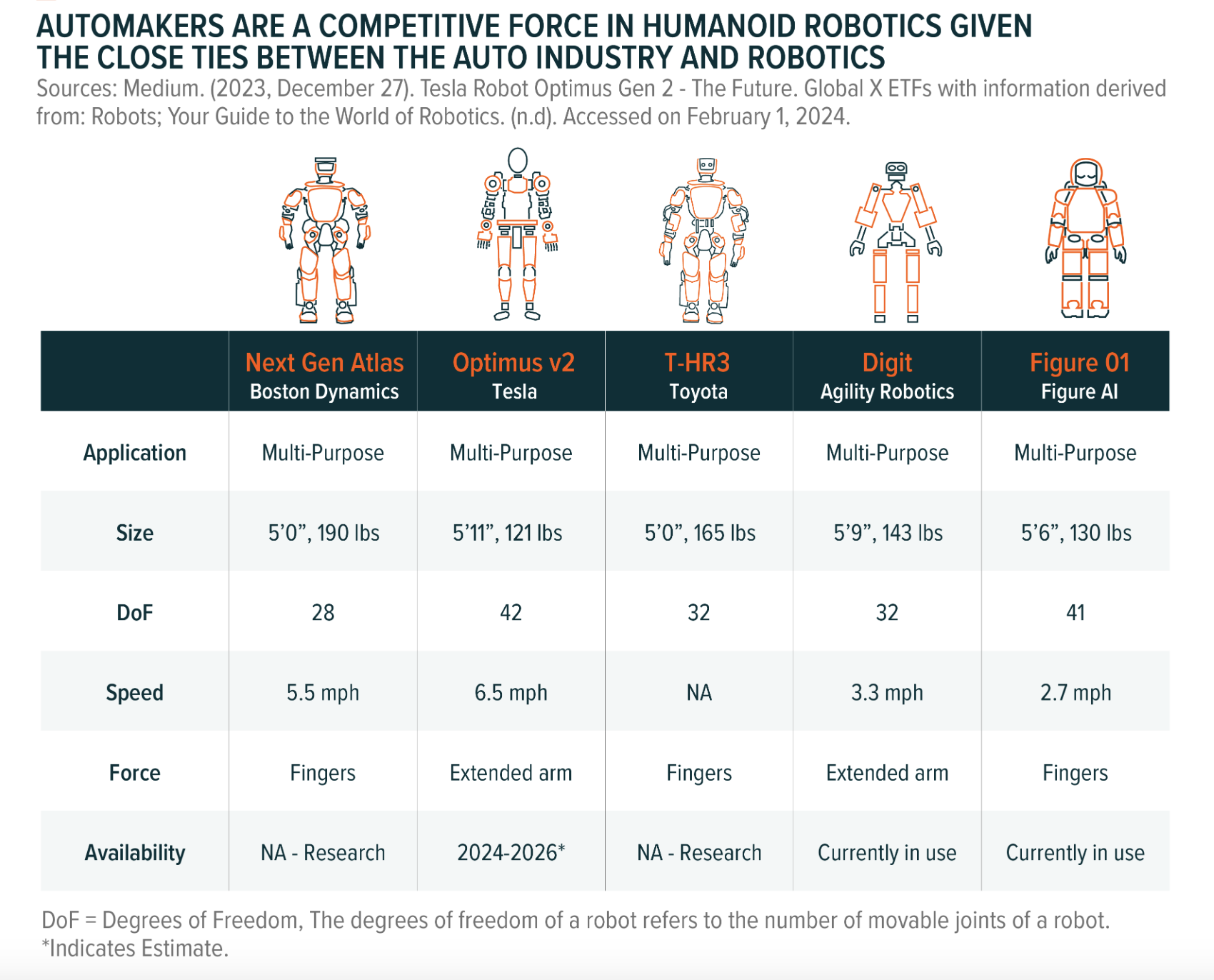
The internet of today is a far cry from its early promise of a democratic network of unbridled innovation. In the last decade, it has fallen under the control of a small number of monopolistic companies like Apple, Google and Facebook; companies that limit the creative potential of the internet while seizing its proceeds for themselves.
There is an alternative. Chris Dixon, a General Partner at Andreessen Horowitz, has long advocated for a technology that can revive the dream of an open, entrepreneurial internet: blockchain networks. Often dismissed, sometimes vilified, these networks have until recently been dominated by amoral speculators and get-rich-quick schemes. But, more quietly, a group of visionaries have been using them to build the future.
In Read Write Own, Dixon draws on 25 years at the vanguard of tech innovation to explore how blockchains will change the internet. He starts by introducing the three eras of the web. First came the ‘read’ era, in which the earliest networks democratized information – creating an anarchic playground for bloggers, coders and artists. Next came the ‘read-write’ era, in which sprawling corporations democratized publishing – turning us all into small-time content creators but offering us few of the rewards.
We are now entering the ‘read-write-own’ era, sometimes called web3, in which blockchain networks have begun to democratize ownership – returning power and economic benefit to all who use the internet. And it is an internet we can all help create. Lucid and practical, Read Write Own offers both a vision of a better internet and a playbook for how to realise it.
Excerpts from the book
1. The nature of permission
In business, permission seeking is not like asking your parents or teachers for permission, where you get a simple yes or no answer. Nor is it like traffic lights setting the rules of the road. In business, permission becomes a pretense for tyranny. Dominant tech businesses leverage the power of permission to thwart competition, desolate markets, and extract rents. (p. xvi)
2. Software as art
Software is so expressive that it is better thought of not as engineering but as an art form. The plasticity and flexibility of code offer an immensely rich design space, far closer in the breadth of possibilities to creative activities like sculpting and fiction writing than engineering activities like bridge building. As with other art forms, practitioners regularly develop new genres and movements that fundamentally shift what’s possible. (p. xx)
3. The problems blockchains solve
The ability for blockchains to make strong commitments about how they will behave in the future allows new networks to be created. Blockchain networks solve problems that plague earlier network architectures. They can connect people in social networks while empowering users over corporate interests. They can underpin marketplaces and payment networks that facilitate commerce, but with persistently lower take rates. They can enable new forms of monetizable media, interoperable and immersive digital worlds, and artificial intelligence products that compensate — rather than cannibalize — creators…. Asking “What problems do blockchains solve?” is like asking “What problems does steel solve over, say, wood?” You can make a building or railway out of either. But steel gave us taller buildings, stronger railways, and more ambitious public works at the outset of the Industrial Revolution. With blockchains we can create networks that are fairer, more durable, and more resilient than the networks of today. (pp. xxiii–xxiv)
4. A new internet era
The decisions we make now will determine the internet’s future: who builds, owns, and uses it; where innovation happens; and what the experience will be for everyone. Blockchains, and the networks they enable, unlock the extraordinary power of software as an art form, with the internet as its canvas. The movement has an opportunity to change the course of history, to remake humanity’s relationship to the digital, to reimagine what’s possible…. This is a chance to create the internet you want, not the internet you inherited. (p. xxviii)
5. The supremacy of networks
Network design is destiny.Networks are the organizing framework that enables billions of people to intelligibly interact. They decide the world’s winners and losers. Their algorithms decide where money and attention will flow. The structure of a network guides how that network will evolve and where wealth and power accumulate. Given the scale of the internet today, software design decisions up front, regardless of how seemingly small, can have cascading downstream consequences. Who controls a given network is the central question when analyzing power on the internet. (p. 3)
6. Protocols vs. corporations
The difference between a protocol network like email and a corporate network like Twitter is that email’s network effect accrues to a community instead of a company. No company owns or controls email and anyone can access it through software created by independent developers that supports the underlying protocol. It’s up to developers and consumers to decide what to build and use. Decisions that affect the community are made by the community. (p. 18)
7. The impact of new technologies
People use new technologies in one of two ways: (1) to do something they could already do but can now do faster, cheaper, easier, or higher quality; or (2) to do something brand-new that they simply couldn’t do before. Early in the development of new technologies, the first category of activities tends to be more popular, but it’s the second set that has more lasting effects on the world. (p. 27)
8. The corporate-controlled internet
Corporate networks have a simple structure. In the middle, a company controls centralized services that power the network. This company has complete control. It can rewrite its terms of service, determine who has access, and redirect how money flows, at any time, for any reason. Corporate networks are centralized because there is ultimately one person, usually the chief executive officer, who makes all the rules. (p. 31)
9. Blockchains as non-consensus bet
Blockchains are different. They’re a non-consensus bet. While plenty of people recognize their potential — including me — much of the establishment disregards them. In fact, a prevailing view in the tech industry assumes that the only vectors of technological improvement that matter are the ones incumbents are already focused on: bigger databases, faster processors, larger neural networks, smaller devices. The view is myopic. (p. 52)
10. How hobbies fuel future industries
Outside-in technologies arrive, in contrast, on the fringes. Hobbyists, enthusiasts, open-source developers, and startup founders hatch them outside the mainstream. The work usually involves less capital and formal training, which helps level the playing field with insiders. A lower bar also causes insiders to take these technologies and their proponents less seriously…. Hobbies fuel future industries…. Hobbies are what the smartest people spend time on when they aren’t constrained by near-term financial goals. I like to say that what the smartest people do on the weekends is what everyone else will do during the week in ten years. (pp. 53–54)
11. The simplicity of tokens
What tokens are matters less than what they do.Tokens can represent the ownership of anything digital, including money, art, photos, music, text, code, game items, voting power, access, or whatever people come up with next. Using some additional building blocks, they can also represent real-world things, like physical goods, real estate, or dollars in a bank account. Anything that can be represented in code can be wrapped inside a token to be bought, sold, used, stored, embedded, transferred, or whatever else a person might want to do with it. If that sounds so simple as to seem trivial, that’s by design. Simplicity is a virtue. (p. 72)
12. Owners vs. users
The concept of ownership is so deeply embedded in our lives that it’s difficult to imagine how the world would look if that were taken away. Imagine if the clothes you bought could be worn only in the venue you bought them in. What if you couldn’t resell or reinvest in your house or car? Or what if you had to change your name wherever you went? This is the digital world of corporate networks. (p. 80)
13. Blockchains as cities
Blockchain functions have neat analogues in urban planning. Starting a blockchain network is like building a new city on undeveloped land. The city designer constructs some initial buildings and then designs a system of land grants and tax incentives for residents and developers. Property rights — ownership — play a key role, providing strong commitments that property owners will get to keep what they own and can feel comfortable investing in it. As the city grows, so does the tax base. Taxes are reinvested into public projects like streets and parks, more land is given away, and the city grows. (p. 97)
14. Restoring community through tokens
Blockchain networks bake community ownership into their core design. It’s in their DNA. While memecoin mutations, like Dogecoin, may seem like a joke, they show how users are embracing all sorts of tokens — some silly, some serious — in search of community, to fill the void left by corporate networks. The internet was originally envisioned as a decentralized network owned and controlled by its participants. Tokens restore that vision. (p. 140)
15. Blockchains as network constitutions
Network designers can use blockchains to create formal rules that are enforced by code. These rules are like constitutions for networks. What these constitutions say is subject to debate, contention, and experimentation, but their very existence, the ability to enshrine rules in immutable software, is a meaningful advance that was not possible in previous network designs. (p. 167)
16. Crypto’s two cultures
Two distinct cultures are interested in blockchains. The first sees blockchains as a way to build new networks…. I call this culture the computer because, at its core, it’s about blockchains powering a new computing movement. … The other culture is mainly interested in speculation and money-making. Those of this mindset see blockchains solely as a way to create new tokens for trading. I call this culture the casino because, at its core, it’s really just about gambling. … The casino should not hold the computer down. (pp. 171, 181)
17. The good old days
Blockchains are at the computing frontier, as PCs were in the 1980s, the internet was in the 1990s, and mobile phones were in the 2010s. People look back today on classic moments in computing and wonder what it was like to be there. Noyce and Moore. Jobs and Wozniak. Page and Brin. Hobbyists dabbling, debating, driving forward. Tinkerers hacking away on nights and weekends.What seems late is actually early. Now is the time to reimagine what networks can be and what they can do. Software is an un- beatable playground for ingenuity. You don’t have to accept the internet as you found it. You can make something better . . . as a builder, as a creator, as a user, and, most important, as an owner.You are here now. These are the good old days. (p. 230)
Driving out of Athens this week, away from the awe of the Acropolis, the majesty of the Panathenaic Stadium, and long lunches of Plaka, I headed down the coastal road. On my right was the beautiful, glimmering Aegean Sea. On my left was mile after mile of construction site.
After Greece’s economic crisis of the last decade, it is firmly now on an upwards economic trajectory. And this, place – variously described as a smart, sustainable megacity, and a coastal park – is the largest redevelopment project in Europe, and a great example of returning Greek confidence.
Lamda Development’s ambitious $8 billion Ellinikon project rises from the Mediterranean coastline, on land which once served as an international airport and the site of the 2004 Olympics.
The Ellinikon project boasts impressive features, including a 1-km-long public beach and one of the world’s largest coastal parks—effectively doubling the green space available to Athens residents.
Among its offerings are thousands of luxury apartments, shopping centres, hotels, offices, entertainment venues, and even a university. Additionally, the development incorporates forward-looking infrastructure, such as electric vehicle stations and rainwater capture systems.
Privately financed by Lamda, this monumental project is expected to generate thousands of jobs, attract tourists, and contribute approximately 2.4% to Greece’s GDP—an economic boost that aligns with Greek Prime Minister Kyriakos Mitsotakis’ focus on growth.
Lamda Development’s CEO, Odisseas Athanasiou, aptly describes it as a venture that puts Greece on the global map for all the right reasons.
Growth is the oxygen of business. It is a relentless journey towards better. It doesn’t necessarily mean being the biggest, but it does mean driving progress. Doing more, achieving more. Yes, over time, it needs to be profitable. And yes it needs to be sustainable, enduring and with positive impact.
So what drives, sustains, and accelerates, profitable growth?
Here we explore some of the most interesting growth companies, with links to their latest performance – selected to demonstrate the different approaches to growth, as well as their performance:

Growth Champion: Amazon
“Earth’s most customer-centric company” has been a relentless growth business for over more than 25 years, from online bookstore to everything store, since Jeff Bezos started out in his garage, back in 1994. Critical to growth has been a long-term perspective, driven initially by private ownership, extension to a marketplace platform, the broader partner ecosystem, the flywheel model, Prime customer membership, and its most profitable business, AWS.
- Amazon
- Amazon Case Study (Strategos Institute)
- Amazon Strategy Teardown (CB Insights)
- How Amazon built a Growth Ecosystem (Growth Hackers)
- Amazon Profile and Jeff Bezos Profile (Peter Fisk)
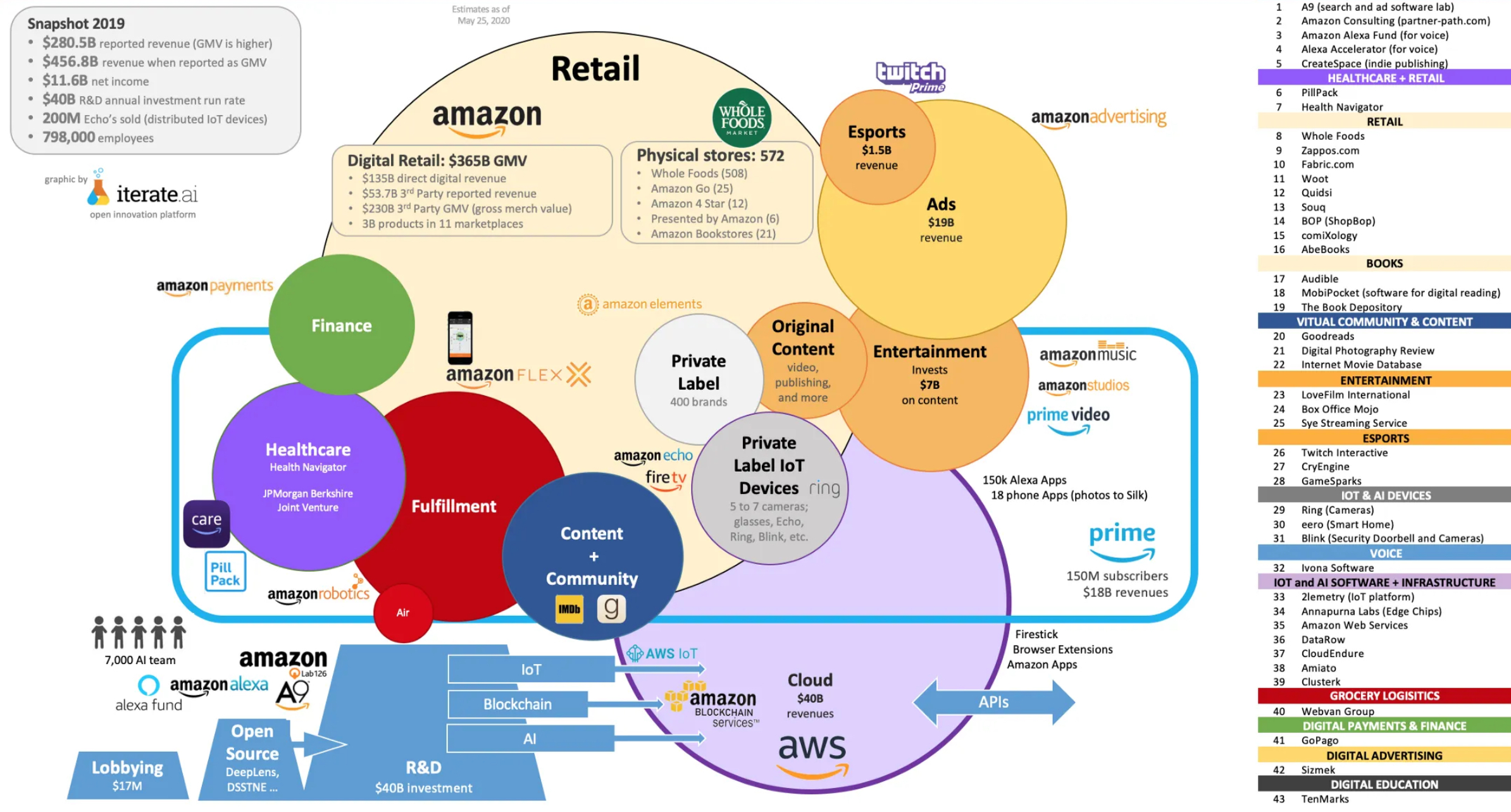
Growth Champion: Authentic Brands
Jamie Salter leads Authentic, experts in taking tired old brands and finding new growth. Authentic started with celebrity brands – like Marilyn Monroe and Elvis Presley, and more recently David Beckham. Since then it has rejuvenated brands including Reebok, Forever 21, Juicy Couture, Nine West, and Ted Baker. The business model is to take charge of the brand and business strategy, while leaving partners to operate, and create synergies between brands.
- Authentic Brands Group
- Authentic Brands Investor Presentation 2022
- Adidas sells Reebok to Authentic Brands for $2.3bn
- Jamie Salter Interview (Drapers, 2024)
- Authentic Brands Profile (Peter Fisk)
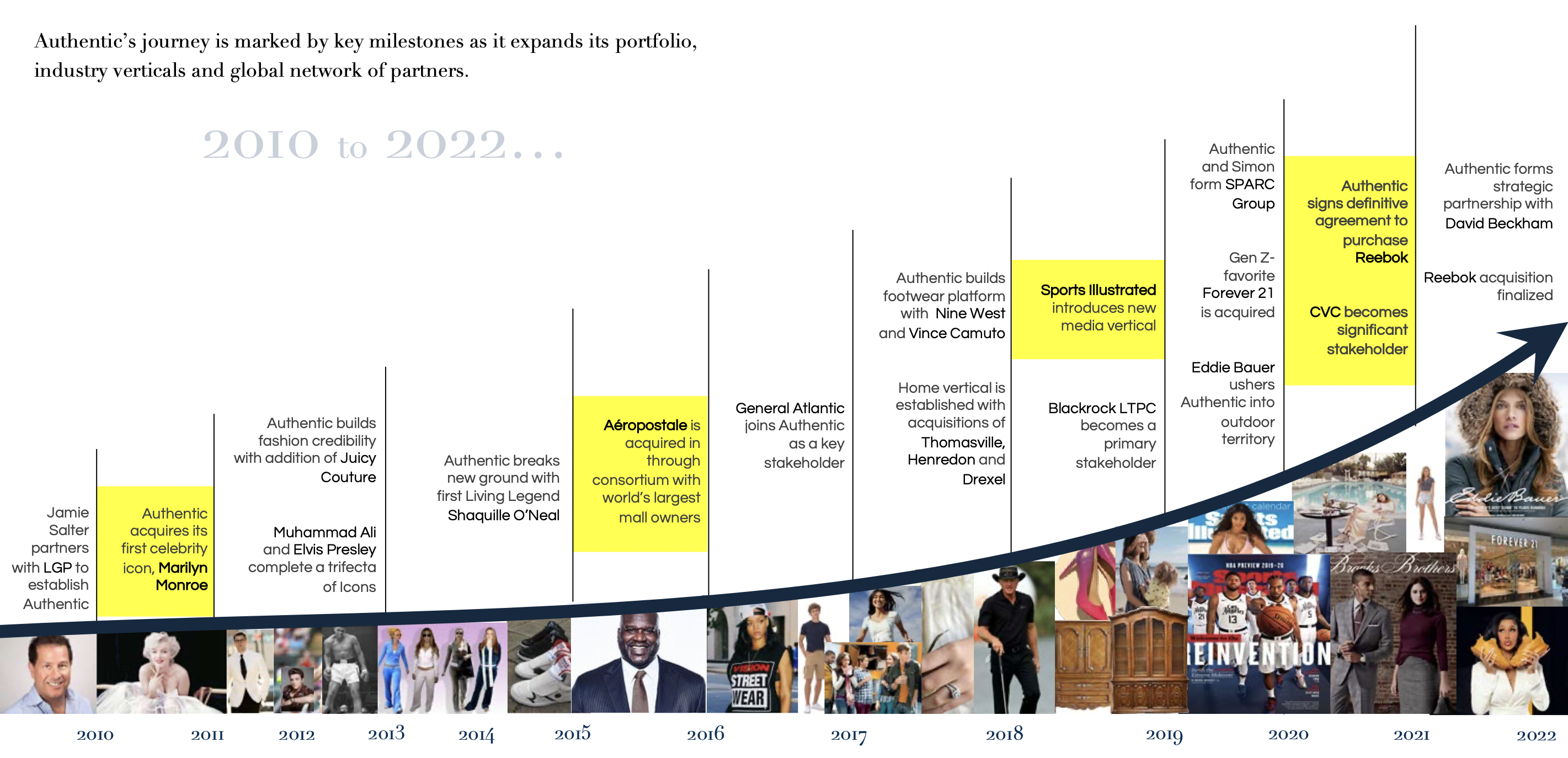
Growth Champion: Coca-Cola
Growth becomes harder as a business matures. Coca-Cola has learnt to keep evolving as markets, consumer tastes and cultures change. Key has been to retain a “human-centric” approach to brand experience, with deep insight into consumers, and the broader cultural context, leading to identifying new niches, new products, new channels, new engagement, and an ever-shifting portfolio. Innovation examples include AI-driven Coca Cola Creations, and Project Shaken, a cocktail mixer.
- The Coca-Cola Company
- Coca Cola Investor Overview Q3 2023
- Raising the Bar: Marketing and Innovation Q3 2023
- Coca Cola HBC Investor Day 2023
- Coke y3000 future magic (Peter Fisk)
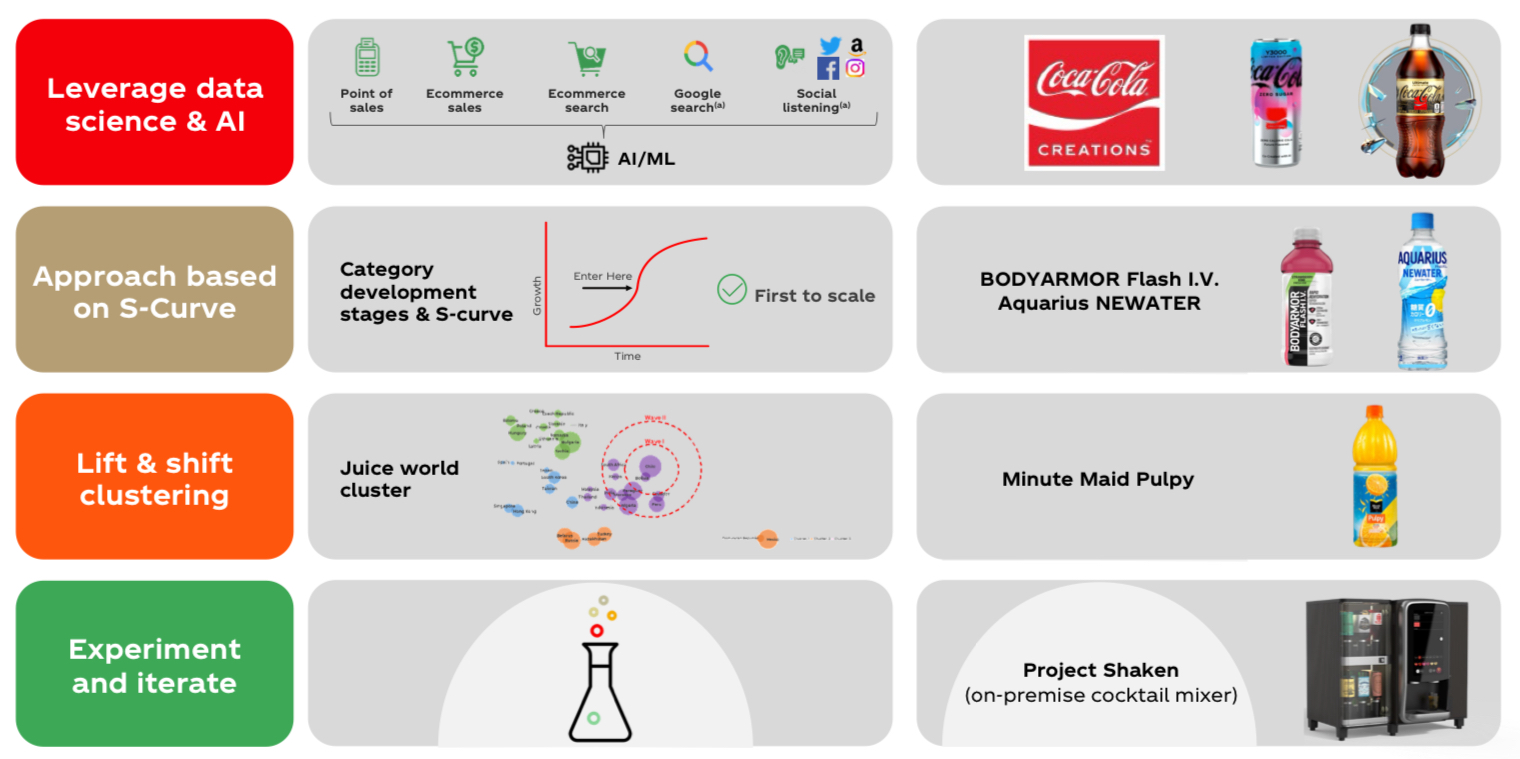
Growth Champion: Crocs
People who love to hate Crocs had cause to celebrate in 2008, when investors were writing the company off as a passing fad. Crocs lost over $185 million that year and stock plunged to just over $1 a share from a high of about $69 a year earlier. But now they are back from the dead, sold 700 million pairs in the last decade, and have become a cultural icon. Crocs are a top brand among Gen Z. And limited edition Crocs are selling for up to $1,000 on the resale market.
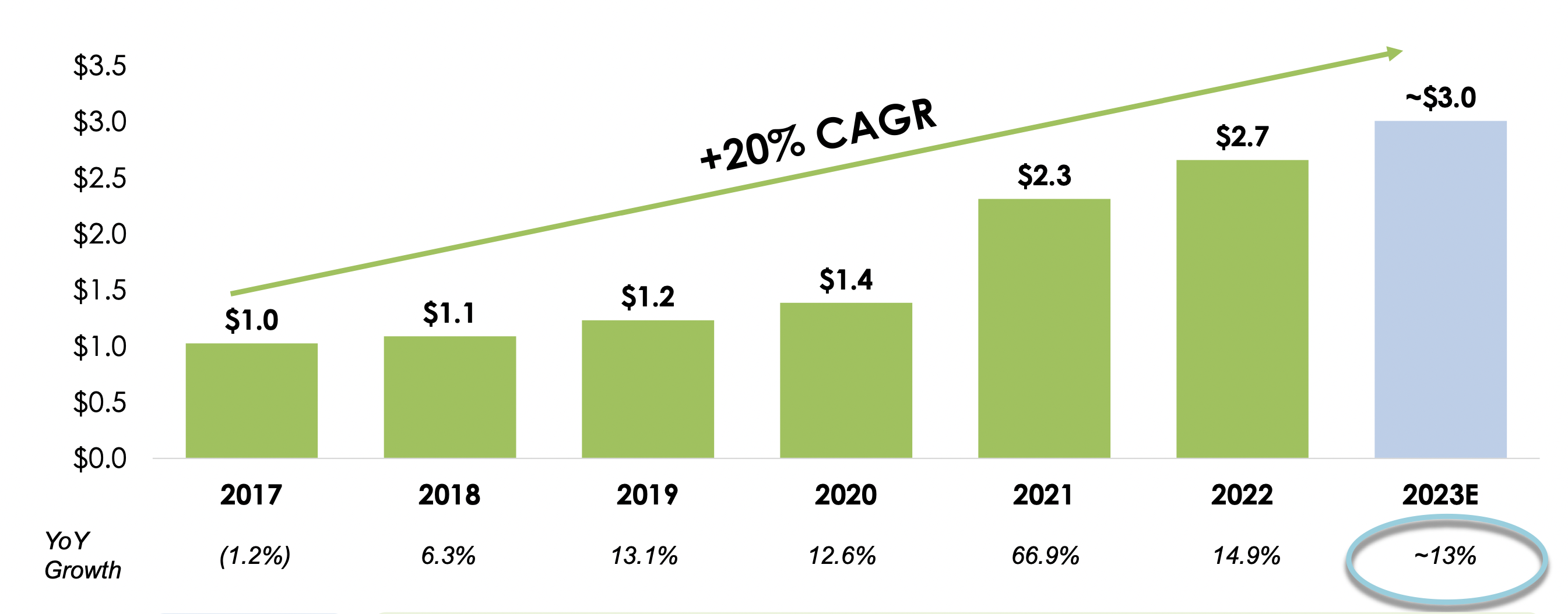
Growth Champion: Essilor Luxottica
The Italian French company is the global leader in the design, manufacture and distribution of eyewear. It licenses many leading brands to develop premium eyewear including Ray-Ban, Oakley, Costa, Vogue Eyewear and Persol. It offers superior shopping and patient experiences with a network of 18,000 stores including world-class retail brands like Sunglass Hut, LensCrafters, Salmoiraghi & Viganò and GrandVision.
- Essilor Luxottica
- Essilor Luxottica at a glance
- Capital Markets Day 2022
- Results Presentation Q3 2023
- Essilor Luxottica Profile (Peter Fisk)
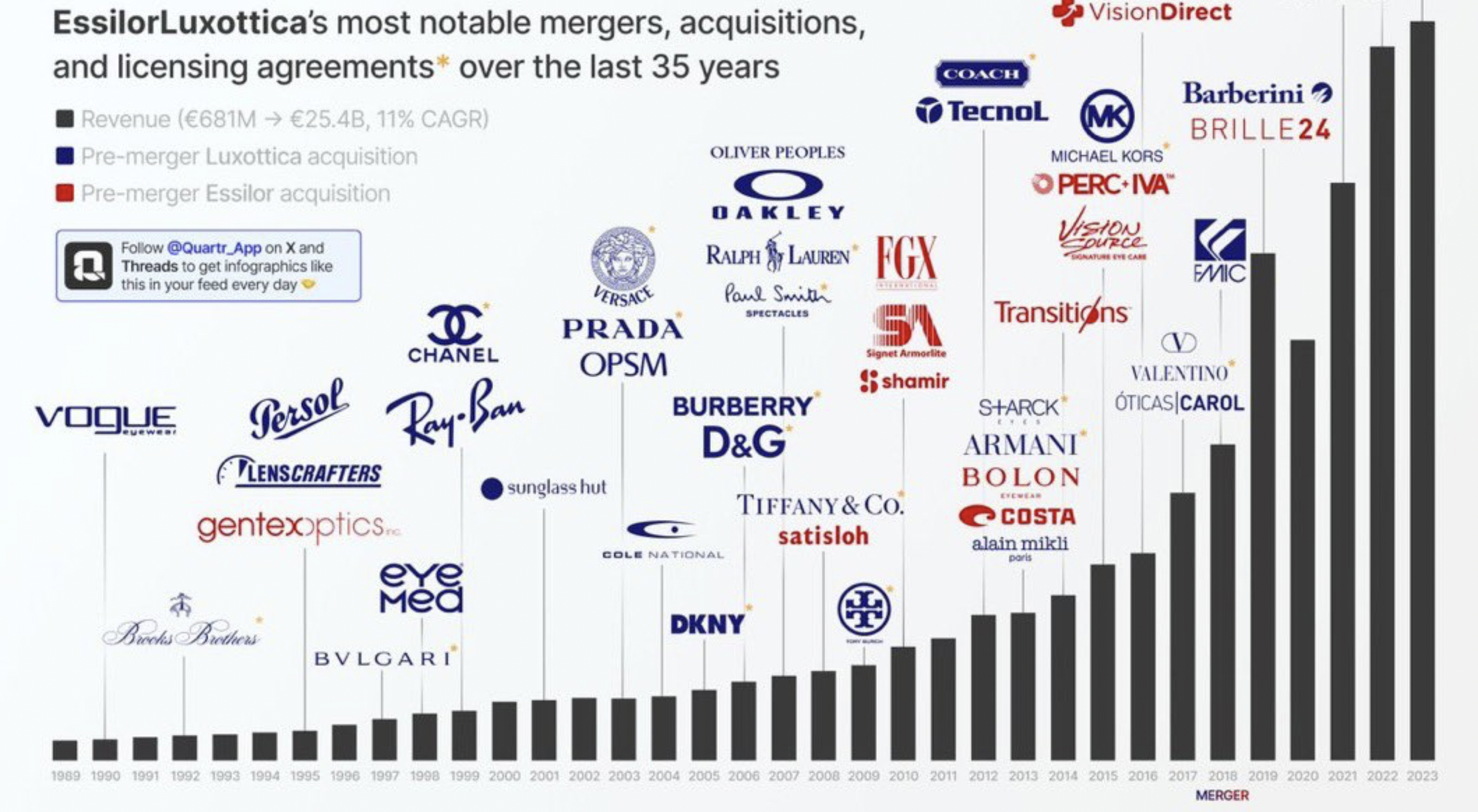
Growth Champion: LVMH
LVMH, from Christian Dior to over 70 luxury brands, including Louis Vuitton and Givenchy, Sephora and Tiffany, has multiplied 20 times in market value under the leadership of Bernard Arnault. In 1984 he spotted an opportunity to acquire a finance company that had lost its way, but still owned some interesting assets including Christian Dior, and department store Le Bon Marche. He quickly set about refocusing the business and reenergising its best assets for a changing world.
- LVMH
- LVMH Snapshot 2024
- LVMH Group Presentation 2023
- LVMH Annual Report 2023
- Bernard Arnault Profile (Peter Fisk)

Growth Champion: Mercado Libre
Mercado Libre is on a mission “to democratize commerce and financial services to transform the lives of millions of people in Latin America”. It hosts the largest online commerce and payments ecosystem in Latin America, and operates in 18 countries, although Brazil alone accounts for 65% of its revenue, growing to 96% when including Argentina and Mexico. MELI was founded in 1999 by Marcos Galperin and two colleagues while at Stanford.
- Mercado Libre
- Mercado Libre Institutional Presentation 2023
- Six Stories of Mercado Libre (The Generalist)
- Marcos Galperin Profile (Peter Fisk)
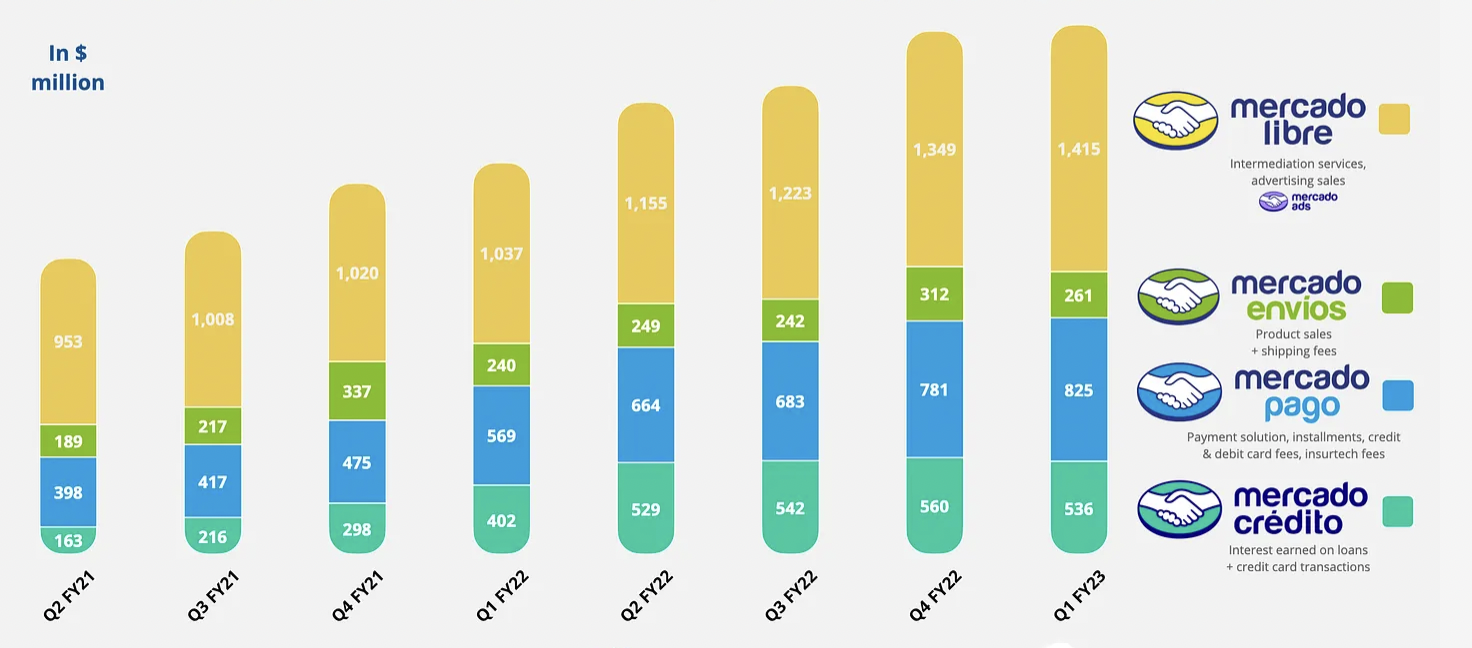
Growth Champion: Monster Beverage
Monster Beverage is the top-performing US business of the past 30 years – a $1,000 investment in 1994 would be worth $2,000,000 today (+200,000% gain). It produces a range of energy drinks including Monster Energy, Relentless and Burn, but was originally founded as Hansen’s in 1935 in Southern California, selling juice products. Monster is 20% owned by Coca-Cola and benefits from distribution through its global network.
- Monster Investor Presentation 2024
- Monster Annual Report 2022
- Monster Design Case Study
- Monster Profile by Peter Fisk
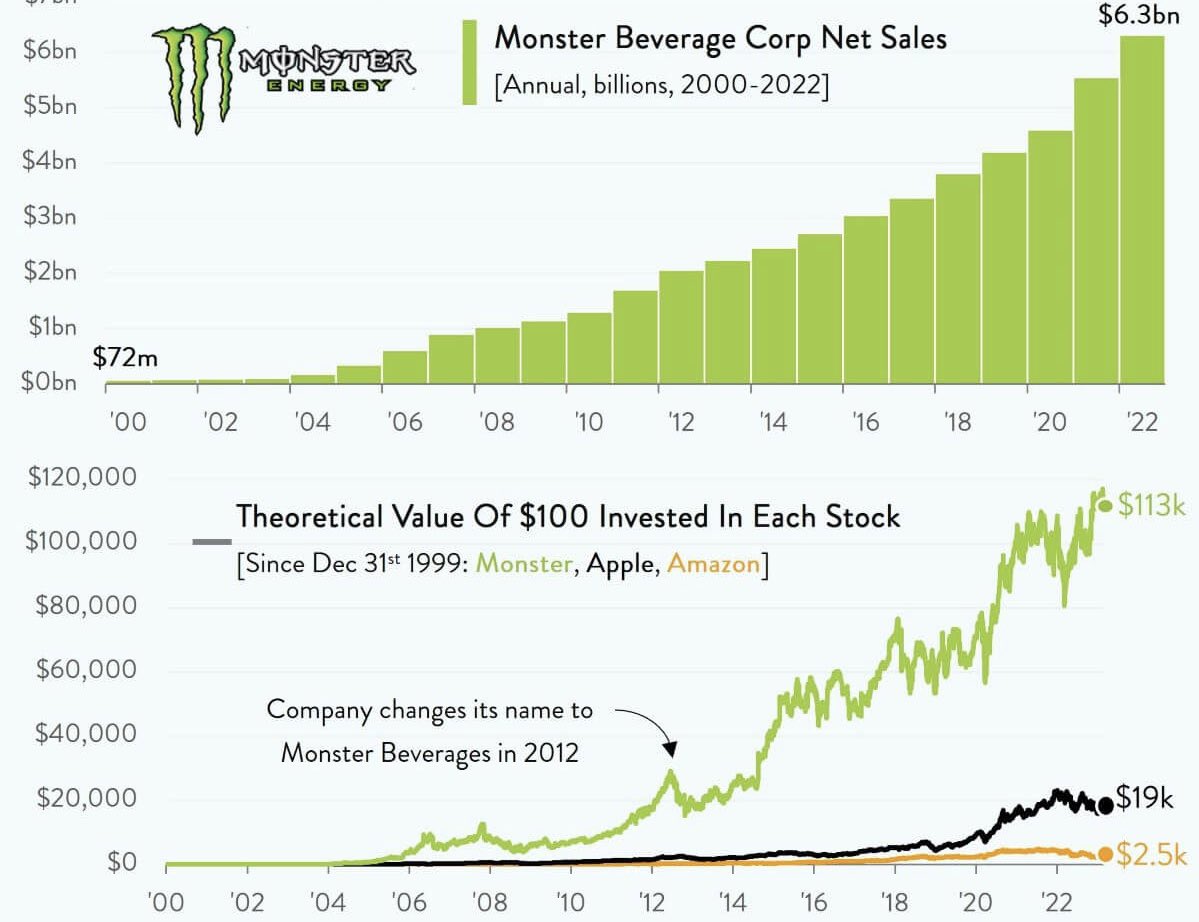
Growth Champion: Novo Nordisk
Novo Nordisk is a global healthcare company, based in Denmark, with more than 90 years of innovation and leadership with a clear focus on diabetes care. It’s innovation is patient-centric, focused on what it can be best at, and delivered by one of the world’s most sustainable companies. Most recently, a new diabetes drug Ozempic was found to have remarkable side effects, creating significant weight loss in patients. It has now become the world’s most in-demand obesity drug.
- Novo Nordisk
- Novo Nordisk Investor Presentation Q3 2023
- Novo Nordisk Corporate Strategy, Capital Markets Day 2022
- Ozempic makes NN Europe’s most valuable company (Peter Fisk)
- Novo Nordisk Profile (Peter Fisk)

Growth Champion: Nubank
Nubank launched in 2013 with the mission to fight complexity to empower people in their daily lives by reinventing financial services. Its first product was a credit card that differentiated itself by not charging traditional fees, such as annual fees or over-limit fees, and all based in a digital app. It is now one of the world’s largest digital banking platforms, serving more than 80 million customers across Brazil, Mexico, and Colombia.
- Nubank
- Nubank Earnings Presentation Q3 2023
- How Nubank became a $30 billion fintech (FT)
- Nubank Profile and Cristina Junqueira Profile (Peter Fisk)
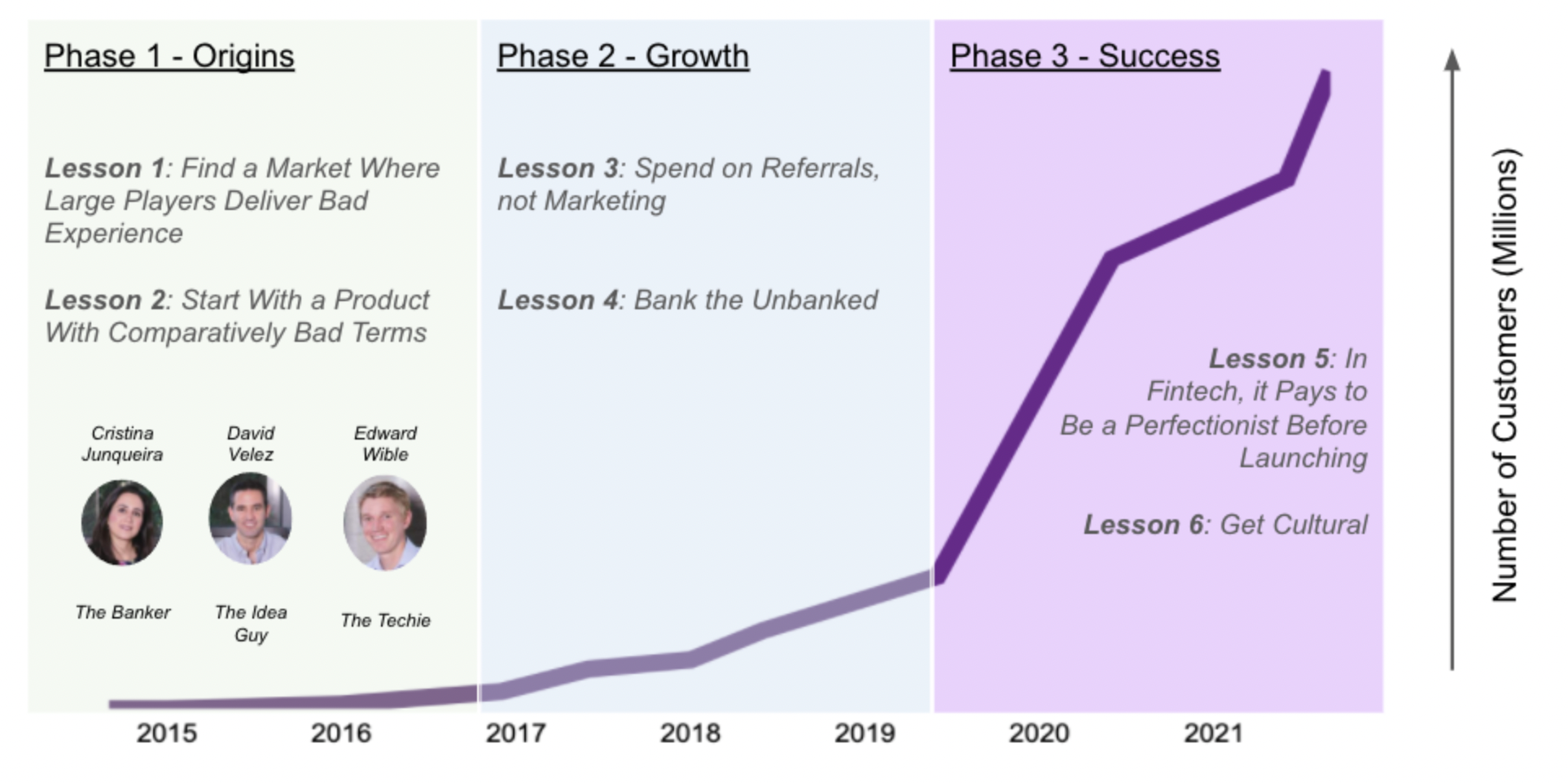
Growth Champion: Nvidia
AI is transforming our world. The software that enables computers to do things that once required human perception and judgment depends largely on hardware made possible by Jensen Huang who cofounded Nvidia in 1993. In 2024, Nvidia’s earnings are forecast to increase at a compound annual growth rate of 103% over the next five years. That would be more than double the 48% CAGR Nvidia’s bottom line has clocked in the past five years.
- Nvidia Story
- Nvidia Investor Presentation Oct 2023
- Nvidia Investor Presentation Nov 2023
- Nvidia growth forecasts (Yahoo Finance)
- Jensen Huang Profile (Peter Fisk)
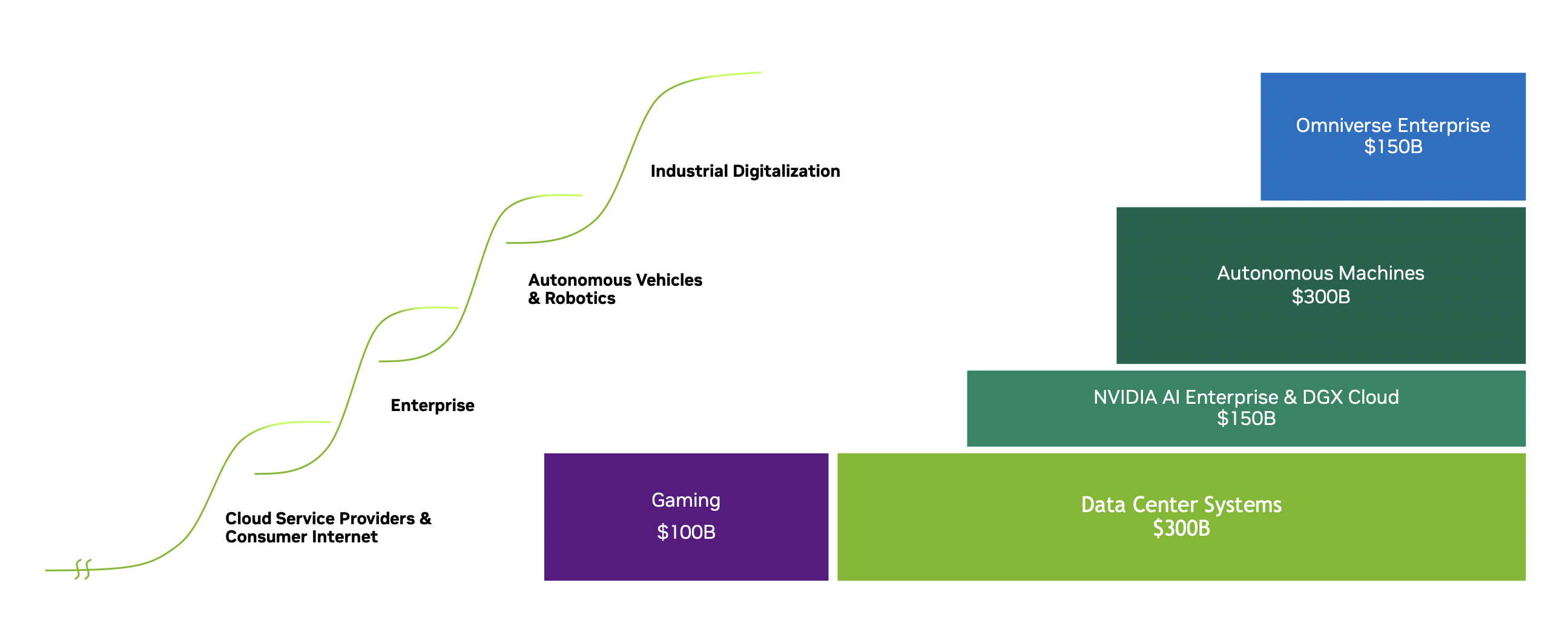
Growth Champion: On
Olivier Bernhard is on a mission to “ignite the human spirit through movement” and to make Swiss brand On “the most premium global sportswear brand”. The former triathlete devoted himself to finding a running shoe that would give him the perfect running sensation. In doing so he crossed paths with a like-minded Swiss engineer who had an idea for a new kind of running shoe. In 2010 he got together with two friends to develop a product range fully engineered in Switzerland.
- On
- On Investor Day 2023
- On Annual Report 2022
- Circular Running (Peter Fisk)
- On Profile (Peter Fisk)
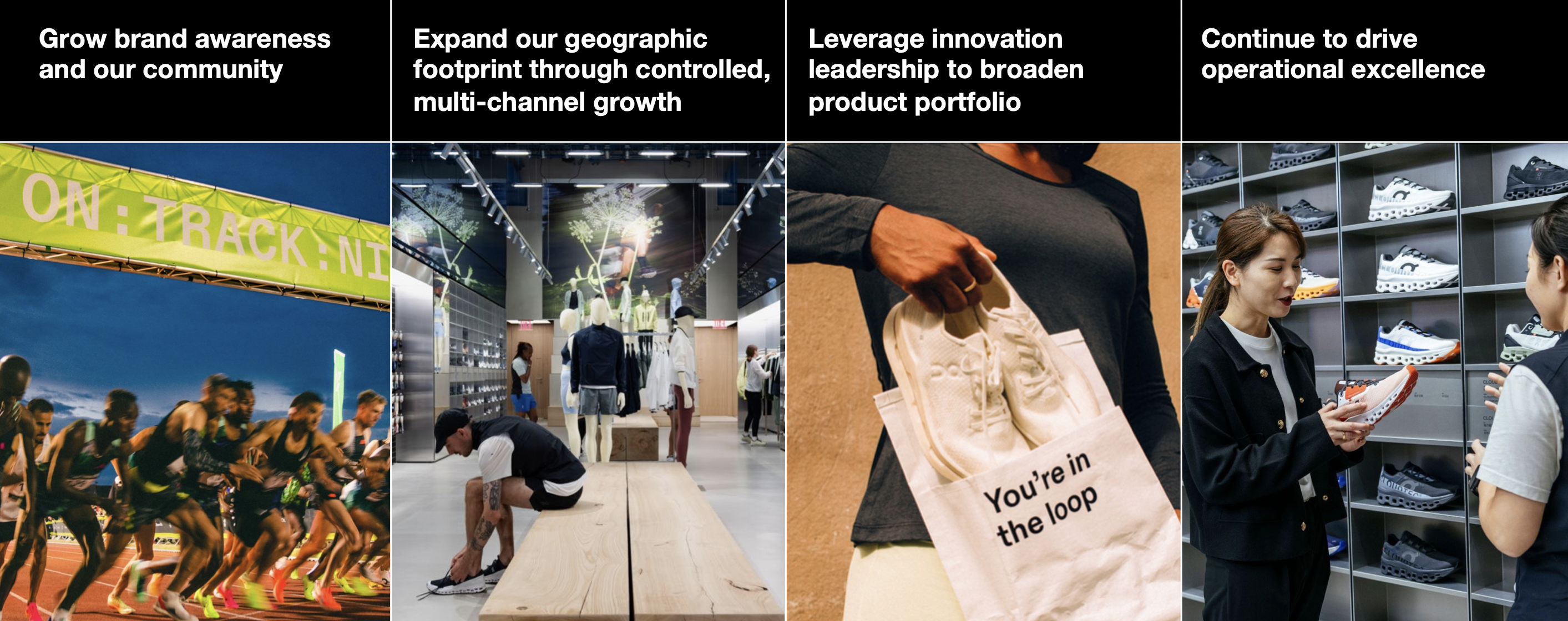
Growth Champion: Ping An
Ping An is the world’s largest insurance business, and more generally provides products and services through its five ecosystems in financial services, healthcare, auto services, real estate services and smart city solutions. The company’s first steps beyond finance started in 2012. Co-CEO Jessica Tan has developed a vision of “technology plus finance” as key to Ping An’s ongoing growth, most notably with Good Doctor as the world’s leading digital healthcare platform.
- Ping An
- Ping An Investor Day 2023
- Ping An Results Presentation Oct 2023
- Ping An Healthcare’s “Good Doctor” (Peter Fisk)
- Ping An Profile and Jessica Tan Profile (Peter Fisk)
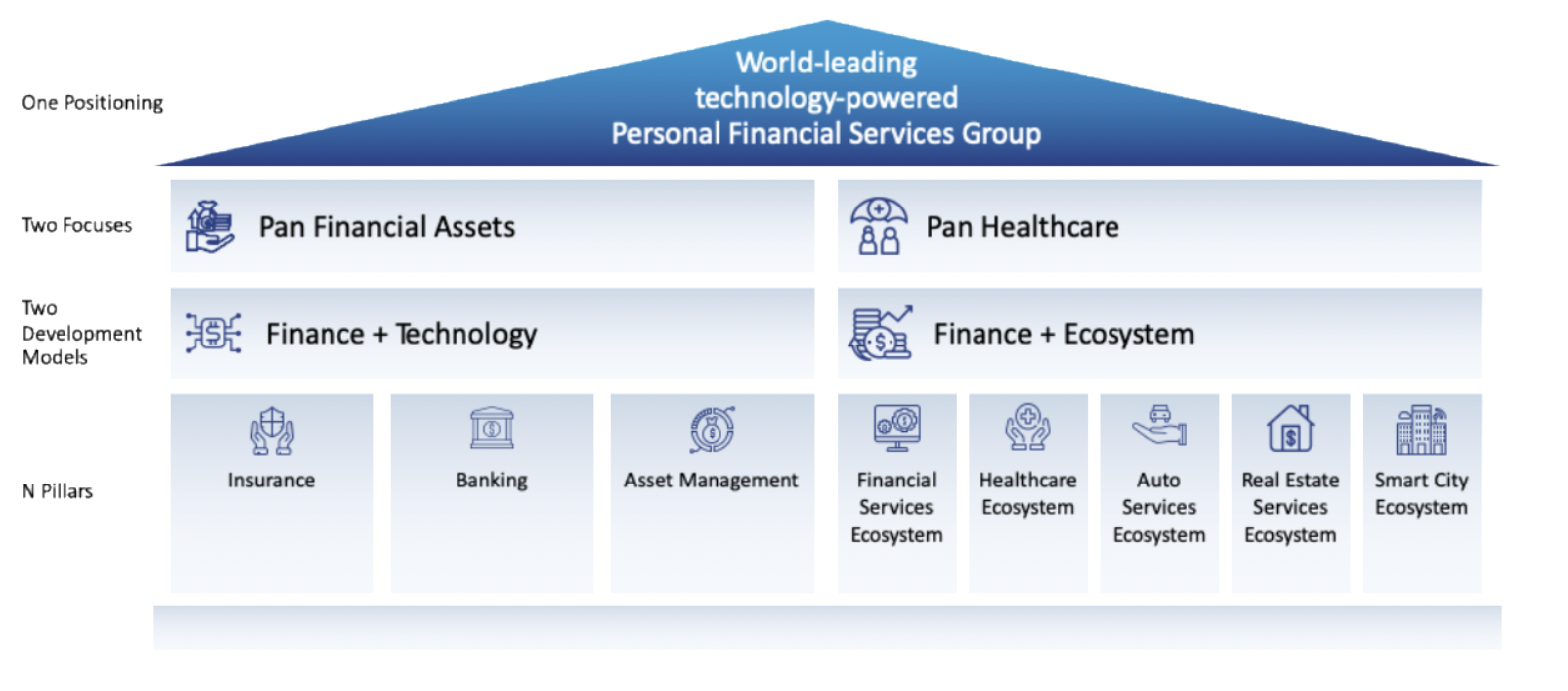
Growth Champion: Temu
The Pinduoduo-owned online fashion. retail platform burst into western markets in September 2022, and immediately outperformed the similar Shein business, and has continued to gain more visitors than Amazon. While Chinese owned, Temu is a US registered company, based in Boston USA. It’s focus is on super-cheap, super-fast, medium-quality fashion, using an on-demand super-fast business model. Sales are driven by social media, live-streaming, relentless offers, and gamification.
- Pinduoduo Overview 2022
- Is Temu the future of buying things? (New Yorker)
- How Temu works (EJet Sourcing)
- Temu Profile and Pinduoduo Profile (Peter Fisk)
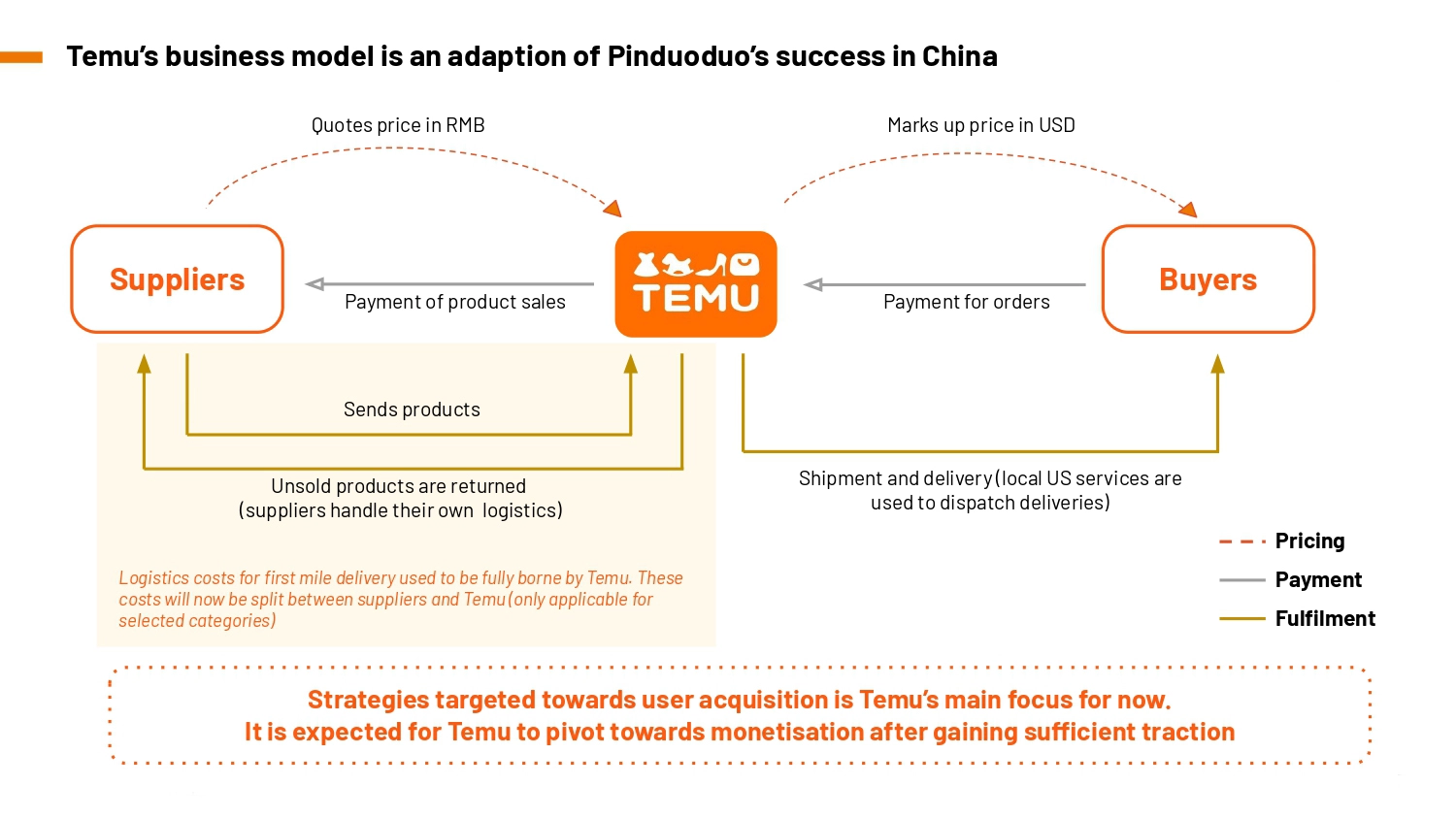
Growth Champion: Tencent
Tencent is a tech ecosystem, with a purpose “Value for Users, Tech for Good”. It’s social platforms WeChat (known as Weixin in China) and QQ connect users with each other, with digital content and daily life services in just a few clicks. It was founded in 1998 by Ma Huateng, known as Pony Ma, in Shenzhen. Launched in 2011, WeChat has grown into the most popular and widely used mobile app globally, and serves as a central part of daily life for its many users in China and beyond.
- Tencent
- Tencent Corporate Overview 2023
- Tencent Results Presentation Q3 2023
- Tencent Profile (Peter Fisk)
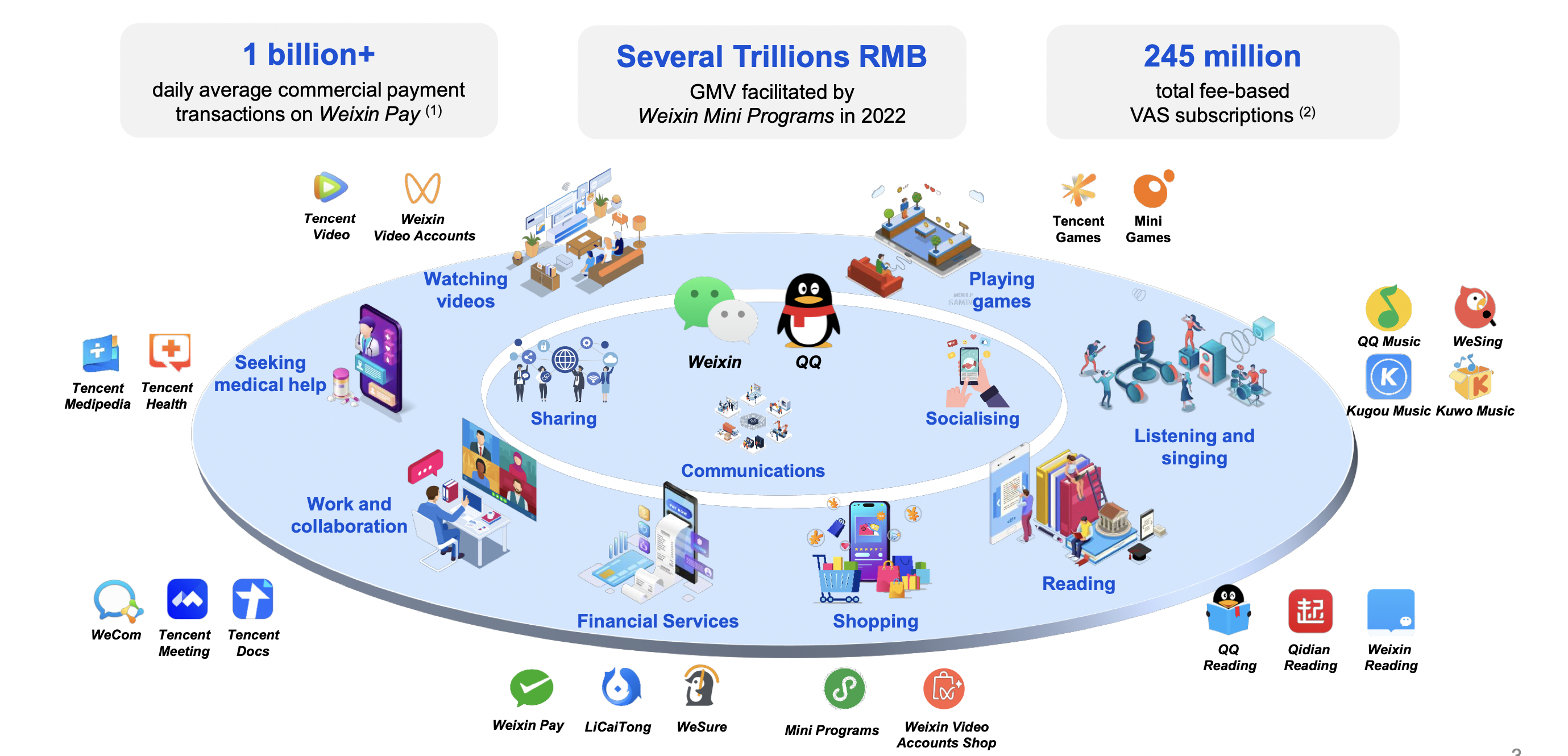
Growth Champion: Tesla
Faster than a Ferrari, powered by the sun. Tesla was founded in 2004 “to accelerate the world’s transition to sustainable energy”. Elon Musk took over as CEO in 2008, and achieved profitability in 2013. Tesla is by far the world’s most valuable automotive company (more valuable than the next 9 companies together), but it is much more than that. Tesla’s latest strategy “Master Plan Part 3” describes how it plans to transform the future of energy.
- Tesla Investor Day 2023
- Tesla Investor Update Q3 2023
- Tesla Master Plan Part 3
- Tesla Profile and Elon Musk Profile (Peter Fisk)
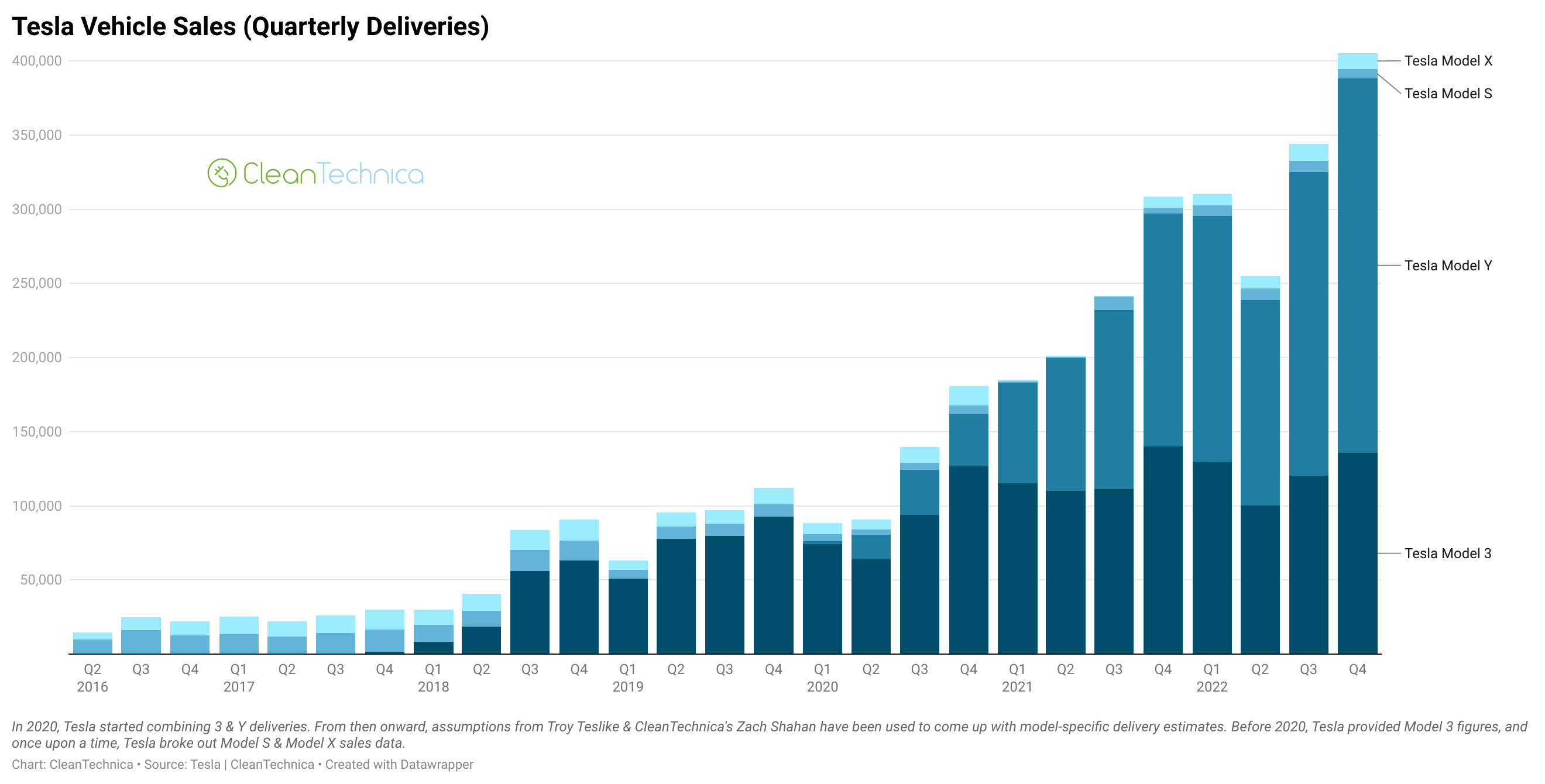
Growth Champion: Tony’s Chocolonely
Dutch journalist, Teun van de Keuken, founded the chocolate company in 2005 to fight against modern slavery on cocoa farms. Over 10 years it grew 10x, 24% a year, and a gross margin of 46%, and is the leading chocolate brand in Netherlands. It’s latest “fair” report starts with “Another choc-tastic year, proving that social impact and economic growth can soar together.”
- Tony’s Chocolonely Annual Fair Report 2022/23
- 10X+ growth from €1m to €100m in 10 years (SOM)
- Tony’s Chocolonely Profile (Peter Fisk)

So what drives growth?
Growth might seem obvious, but it is often confused. Profitable growth is the key driver of value creation.
Consider the automotive market. Tesla has the highest growth rate (around 35% CAGR over 5 years). And while Volkswagen sells 4 times more cars than Tesla ($335 billion to $95 billion revenue in 2023), Tesla is almost 10 times more valuable than Volkswagen ($650 billion vs $65 billion in terms of market cap). Ferrari is the most profitable (25% operating margin to Tesla’s 14%), but is even less valuable than VW, with almost no growth. Tesla, of course, is also the most sustainable.
- How do you drive and sustain profitable growth?
- Does it mean doing more? Or less, by doing the best things better?
- Is it all about smarter selling, or more about innovating?
- To existing markets and customers, or looking beyond to new opportunities?
- How does growth fit with sustainability, and using less natural resources?
- Can inorganic growth replace the need for real, organic growth?
- Is growth still the primary way to drive long-term value creation financially?
- Does growth need a strategy, and active leadership, or is it just a result?
- What inspires growth, sustains growth, and accelerates growth?
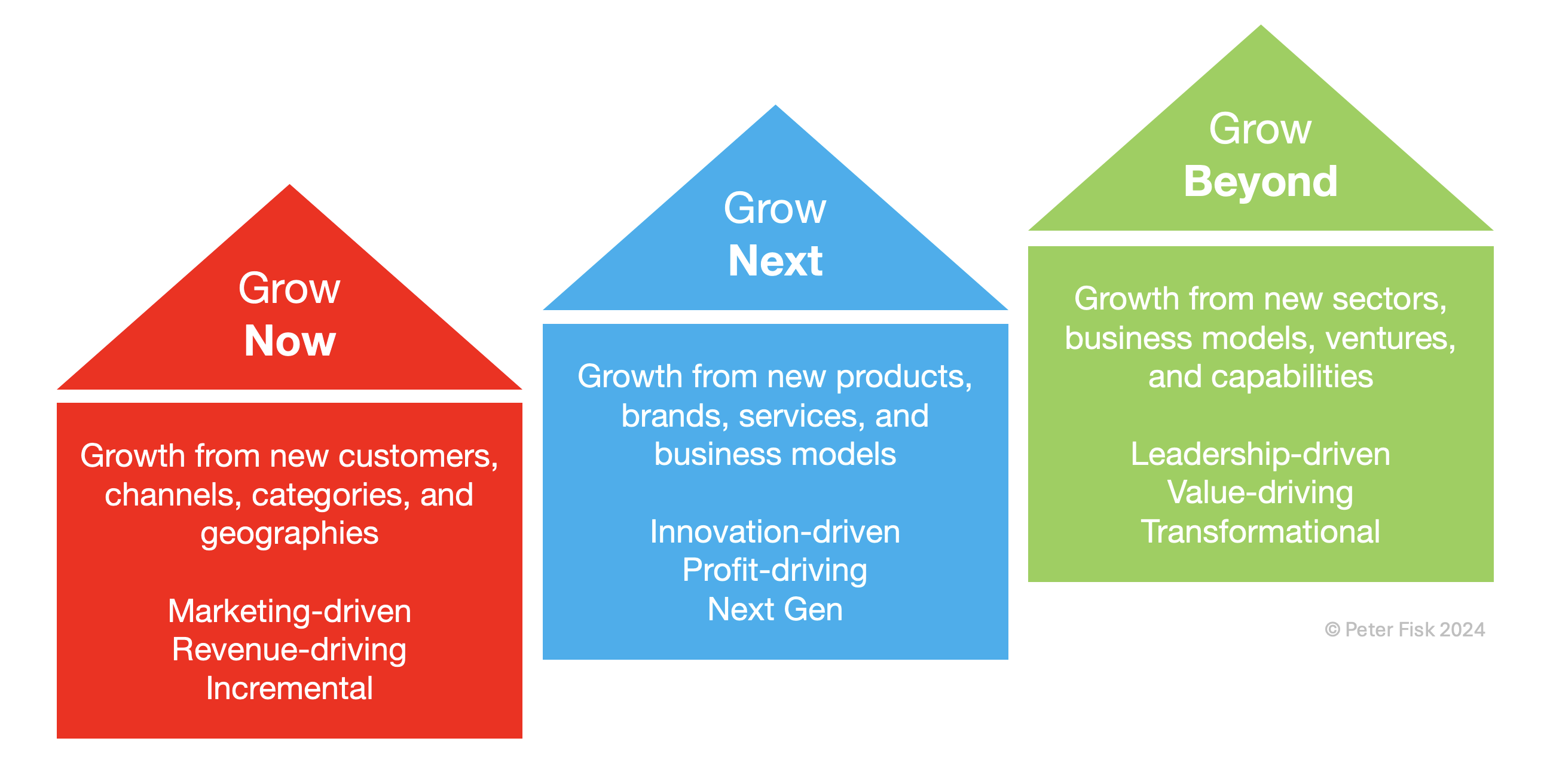
Explore more about growth
- Growth Recoded (video) by Peter Fisk
- Finding and accelerating better growth by Peter Fisk
-
Growth in an uncertain world by Deloitte
- 4 Stages of Growth: Start-up, Grow-up, Scale-up
-
Video: AG Lafley on Growth Strategy
- Video: Inside P&G’s Growth Factory
- Now New Next: Growth Champions by Mckinsey
- Leading for Growth by McKinsey
- Growth Triple Play by McKinsey
- 6 Strategies for Growth by McKinsey
-
10 Rules of Growth by McKinsey
- Summary of Growth IQ by Tiffani Bova
- Growth IQ Workbook by Tiffani Bova
- Life Centricity Playbook by Accenture
- 11 Secrets for Exponential Growth by Salim Ismael
And also
- New topics for inspiring growth keynotes by Peter Fisk
- Practical strategic growth workshops by Peter Fisk
- Accelerated executive development by Peter Fisk
War. Inflation. Recession. Pandemic. The pursuit of economic stability is increasingly unrealisable, with the volatility of recent years challenging leaders and companies to find new ways to create value as they navigate the changing business landscape.
When turmoil hits, business leaders and investors face notoriously unreliable macroeconomic forecasts, whipsawing data, and contradictory opinions. Are disruptions transient and ephemeral—or permanent and structural? False alarms are costly traps, but so are true structural changes that go undetected. Leaders must also assess the doom-laden public macroeconomic discourse, which habitually presents worst-case scenarios as foregone conclusions.
How can business leaders avoid these traps and make better strategic decisions?
Shocks, Crises, and False Alarms
In his new book, Shocks, Crises, and False Alarms, BCG Global Chief Economist Philipp Carlsson-Szlezak and Senior Economist Paul Swartz provide a fresh and accessible way to analyse and understand the macroeconomy, or what they call “regime analysis”, that pushes beyond conventional model-based prediction to emphasise structural context and judgment.
Focusing on what it takes for macroeconomic regimes to break, they apply their approach to key risks in the real economy, financial structures, and geopolitical arrangements to help senior executives and investors assess the true risks of their economic context and to build their capacity to respond to changing conditions more effectively.
With dose of rational optimism, the book explores the key macro debates and controversies that shape our time, and it empowers leaders with the analytical skills to assess and judge macroeconomic risks for themselves, with a new way of thinking that will continue to apply as risks change over time.
- New: 8 CEO Priorities for 2024 by McKinsey
- New: Leadership Agenda in 2024 by PwC
- New: CEO Outlook 2024by EY
- New: Tech Trends 2024 by FTI
- New: Big Ideas 2024 by ARK
- New: Global 50 by DFF
Trend Kaleidoscope 2024 is a compilation of over 50 reports about economic and industry outlooks, market and consumer trends, emerging technologies and new possibilities, and much more. We all recognise the uncertainty driven by conflicts, climate and economics, and the spluttering growth of today’s environment – but two big, closely related, trends stand out:
- AI hype and being human … 12 months of ChatGPT has certainly sparked enthusiasm for AI startups, investment and innovation … but at the same time (a legacy of pandemic, and antidote to digitalisation) is the desire to be more human – more personal, empathic, and in search of real experiences, from in-store immersions to meditative moments and travel adventures.
- Sustainable and synthetic reality … technological innovation is taking us in two directions – to address the problems of the past (most significantly, the huge and difficult effort to decarbonise old industries – although energy transition has stalled because of the greed of higher oil prices) – and also a huge rise in new synthetic innovations, from gene-editing and mRNA in healthcare, to alternative foods and VR gaming.
Also take a look at who I see as some of the most innovative businesses who are likely to deliver rapid progress in 2024, just some of the 250 inspiring companies which I track for their innovation and performance:
- Authentic Brands, from Ali to Elvis, Reebok to Ted Baker
- BYD, Chinese EV maker, now the world’s #3 automotive business
- Holcim, Swiss cement, building progress for people and planet
- Lilium, former Airbus and BMW leaders, innovating the future of flight
- MercadoLibre, the Amazon of Argentina, from retail to finance
- Northvolt, pioneering a sustainable battery industry, key to future energy
- Rains, concept meets function in Nordic outerwear from Aarhus
- SSAB, zero carbon steel from Sweden, stronger, lighter and more sustainable
- Twelve, capturing carbon, to make more sustainable plastics and fuels
- Vuori, soft and stylish Californian fashion, ready for IPO in 2024
While looking ahead, it’s also interesting to see how the last year has unfolded – as predicted by Trend Kaleidoscope 2023 – from ChatGPT to $3 trillion Apple thriving on financial services, BYD’s rapid acceleration to lead the auto market, AI-generated influencer Noonoouri’s chart-topping hit with Warner Music, and India joining the space race.
Slower, greener growth
As polycrisis consumes agendas around the world – conflicts, climate and more – the IMF Economic Outlook 2024 sees a continued stagnation of growth in western markets next year (1.2% in Europe, 1.5% in USA) but higher in Asia (4.4% in China, 6.1% in India), and 2.9% average globally.
The EIU’s Industry Outlook 2024 reflects on the turbulence of recent years for most companies as the pandemic, soaring commodity prices, high interest rates and political disruption resulted in profits for many and bankruptcy for some. It produces a weather forecast by industry:
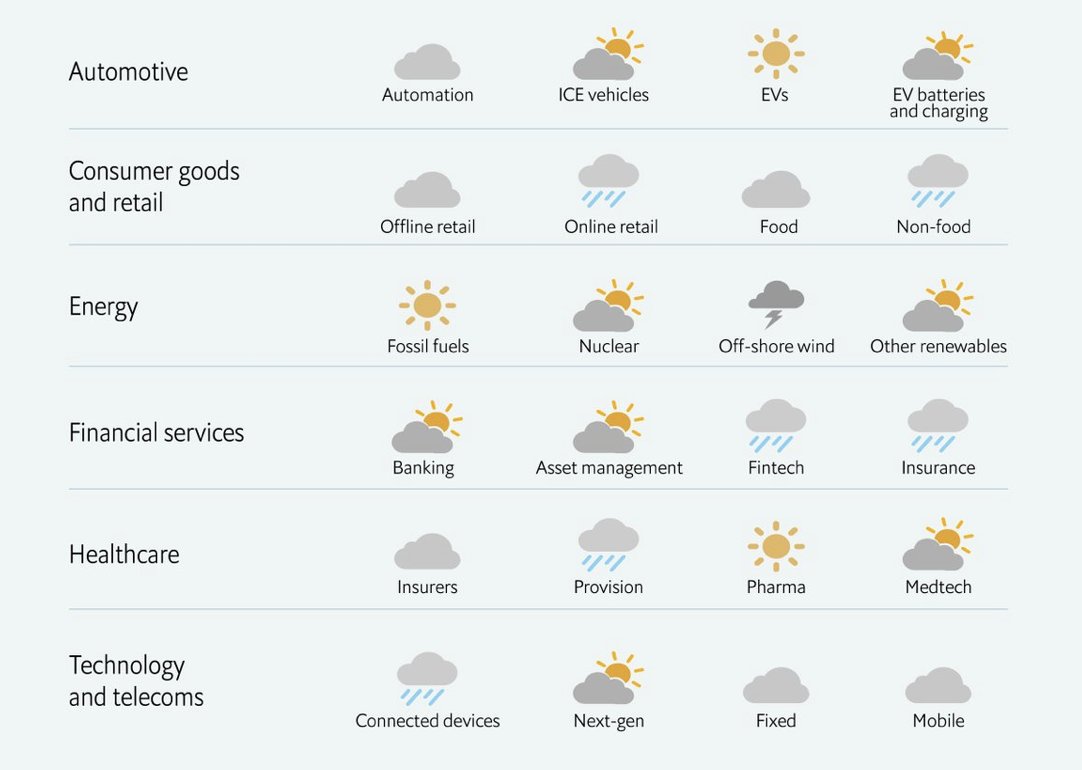
EIU also considers the next agendas on each continent
- Europe 2024: Subdued growth, political fragmentation and the green transition.
- North America 2024: US elections will dominate the year, while the economy will struggle with higher borrowing costs.
- Latin America 2024: substantial political change has led to democratic retreat and social risks.
- Asia 2024: Strong growth despite China’s slowing economy and geopolitical tensions.
Ipsos’ Global predictions for 2024: Optimism is on the rise as more think next year will be better
- 53% say 2023 was a bad year for them and 70% say it was a bad year for their country. This is the lowest level since before the Covid-19 pandemic.
- Seventy per cent think next year will be a better year than this one. This is an increase of 5pp on last year’s figure.
- More people think AI will lead to more jobs being lost than being created in 2024.
- After 2023 being the hottest year on record, 81% expect average global temperatures to go even higher in 2024.
- A majority (59%) think we’ll spend more time working in the office in 2024 than working at home.
The Economist focuses on 10 business trends:
- Central banks including America’s Federal Reserve start to reduce interest rates as price rises slow. With global inflation still at 5%, however, consumers remain thrifty.
- Amid efforts to slow climate change, renewable-energy consumption climbs by 11% to a new high. But fossil fuels still meet over four-fifths of energy demand
- IT spending picks up, rising by about 9%. Artificial intelligence generates remarkable hype but produces precious little revenue and plenty of scrutiny.
- The gap between the infrastructure the world needs and what it gets amounts to $3trn. To plug its infrastructure hole, Asia’s gross fixed investment expands by 4%.
- Revenue in the advertising industry increases by 5%, thanks to America’s presidential election and big sporting events such as the Paris Olympics.
- International tourism rises above geopolitical and economic uncertainty to create record revenue of $1.5trn, fuelled by high prices and post-pandemic wanderlust.
- A greying world spends vigorously on health. With about one in ten people aged 65 or older, health care makes up one-tenth of global gdp.
- America shells out $886bn on defence, supporting Ukraine and countering China—whose neighbours, including Japan, Taiwan and the Philippines, also bolster their defences.
- Electric vehicles speed forth, driven by strong government support. One in four new cars is a plug-in, with more than half of these sold in China.
- With 60% of America’s firms allowing working from home, a fifth of American offices lie empty. The eu’s less relaxed employers will keep its vacancy rate at just 8%.
Being Human
Mintel’s Global Consumer Trends is summarised by these 5 themes:
- Being Human: In a world increasingly dominated by algorithms, we will need human skills and emotion to make the most of this technological revolution. A new ‘human-as-premium’ label will emerge, giving greater influence to artisans who can take on the creative spirit that exists outside of an algorithm
- More Than Money: Consumers will reassess what matters most to them, affecting not only what they want and need, but their perception of what constitutes value. The social and emotional value of a brand will grow in importance as consumers look more towards what a brand means to them personally, rather than what it stands for societally.
- Relationship Renaissance: Consumers who find comfort through screens at the cost of meaningful, real-life relationships, will seek new forms of intimacy for the sake of their physical and mental health. Consumers don’t just want to be cared for; they want to care for others too, including their pets and plants.
- New Green Reality: Incorporating sustainability into the day-to-day is not enough; consumers and brands will be faced with the reality that survival within a new climate context has to be the priority. Anxious consumers may be reluctant to adopt necessary lifestyle changes, which will drive brands to do more to help smooth these transitions.
- Positive Perspectives: Brands and consumers will work together in new ways to deal with uncertainty. To counter the feeling of always waiting for something to happen, consumers are waiting for a clear sense of direction, or profound statements from voices of authority, including brands.
These trends are illustrated by innovations that have emerged in recent months around the world:
- US biotech company Nix launched a wearable hydration biosensor that calculates fluid and electrolyte loss and informs the user about their hydration levels.
- Danish tech start-up Be My Eyes has incorporated OpenAI’s GPT-4 into its eponymous mobile app to create a virtual visual assistant for blind and partially-sighted people that can generate spoken words from images.
- Artists and illustrators in the US are using the hashtag #artbyhumans as a form of silent protest and a rallying cry against the abundance of AI-generated images/art.
- Digital bank Brubank Argentina invited entrepreneurs to use AI and the Mi Negocio app to submit visualisations of their dream store and the bank produced the digital designs for free.
- French cooperative Ethikis has developed the Longtime label, a quality mark to help consumers identify durable products.
- Chinese baijiu brand Wuliangye has launched ‘W Planet’, a metaverse-based virtual space, aimed at encouraging young consumers to experience its brand culture.
- US food processing company Heinz has created a collectable sauce packet for all 50 US states, each one highlighting a regional delicacy from the state to bring Americans together rather than highlight what divides them.
- Chinese fragrance brand Documents has opened a community-based store in Shanghai—‘Yuyuan Bookspace’ (愚园书室)—where consumers can read themed books (eg trees) for free while experiencing Documents’ fragrance products.
- ‘Body doubling’—the practice of using livestreams to replicate the feeling of working alongside others to boost productivity—is becoming increasingly popular among remote workers and students in the US, with virtual platforms like Flow Club matching members in small accountability groups.
- The staff at Tokyo’s Tomodachi ga Yatteru Café (‘Café Run By Friends’) are actors who pretend to know every customer who walks in to make them feel like long-time friends.
- Australian start-up Immersion Group harvests and supplies red seaweed, which produces a compound called bromoform. When fed to cattle and sheep, bromoform blocks an enzyme in the gut that produces methane, thereby, reducing methane levels in livestock farming.
- Coffee and espresso machine maker Nespresso partners with small organic farmers in Taiwan, supplying them with coffee grounds to enrich their soil. Local Italian, vegetarian restaurant Miacucina created a special menu centred around cabbages harvested from farms using these coffee grounds.
- For April Fool’s Day 2023, US-based women’s clothing brand Cuyana launched a fictional clothing line, ‘Made With Air’, stating it had no negative impact on the environment, as a tongue-in-cheek way of drawing attention to brands that greenwash through various environmental claims.
- Indian instant delivery service, Blinkit’s, ‘Recipe Rover’ utilises ChatGPT technology to enable users to explore different recipes and add suggested ingredients to their Blinkit shopping carts.
- The 2023 Faal Festival (‘Failure Festival’) in the Netherlands encouraged young people to embrace failure through talks and activities to improve their mental health.
- Inception is a US-based mental health gym that helps members take a holistic approach to health by achieving ‘inner fitness’ through mindfulness and relaxation.
- Chinese Buddhist temples are launching new offerings, like blessed objects, coffee drinks and mental health counselling, to attract younger generations, making them the latest trendy destination for Gen Z which seeks pleasure and slowness in their hectic lifestyles.
Ethical Zen
Statista’s “Must Watch” Consumer Trends 2024 are strongly driven by the economic context of inflation, rising living costs, and unpredictable demands which are reshaping consumer spending habits and needs.
- Quest for quality: the search for a new quality-value equation in tough economic times. Despite tightened consumer budgets they prefer to buy better, not simply cheaper – better quality, more sustainable – forget disposable consumption and fast fashion. This is leading to a rise in premium products, selectively purchased, but also a thrift economy.
- Ethical spenders: Sustainability and ethics at the forefront of decision-making. Sustainability is no longer just a buzzword. Ethical Spenders will buy from eco-friendly brands, even during challenging times. Ethical Spenders are willing to pay a premium for essential goods that align with their values – especially food and drink, beauty, homeware and fashion.
- Zenthusiasts: The hunt for respite from stress and anxiety is surging. Spearheaded by Gen Z and Millennials, these generations are acknowledging the mounting stressors in their lives. Zenthusiasts are actively seeking solace through online health gurus who promote self-care and alternative therapies like cannabis.
- Data Ad-vocates: Say goodbye to one-size-fits-all advertising. Consumers aren’t as concerned about data privacy if it means they get personalized content and experiences in return. Data Ad-vocates want ads catered to their interests, location, and lifestyle preferences. Personalization can be a powerful way to attract new as well as retain customers.
Where’s the love?
Accenture’s Life Trends 2024 report is a refreshingly human view of emerging behaviours, but from a tech expert company. largely thanks to its acquisition of Fjord which did great work on trends.
The report starts by asking “Where’s the love?”
“For years, the correlation between customer experience and revenue growth inspired organizations to hold the customer at the center of every decision. Now, economic considerations are forcing cuts throughout enterprises, driving friction between customers and brands across channels—in the form of price increases, quality cuts, illogical subscriptions, and poor customer service. Customers are noticing, and some feel hard done by. The key question: How do brands keep their product in the basket in the long term?”
Businesses are scrambling to cut costs and protect profits against a strained economic backdrop.
They’ve made tough decisions to survive, with one major consequence: the erosion of customer experiences. Like it or loathe it, consumerism is a socio-economic fact of life for billions of people, with much of their day-to-day experience influenced or mediated by consumer culture. The changes described in this trend are having a significant impact across multiple aspects of life, affecting how people feel every day.
Until recently, the direct link between profit and customer experience made the latter top priority, often at the expense of other factors.2 Widespread digital adoption in the 1990s—particularly the internet and, later, smartphones—pushed focus onto experience, which hadn’t previously been emphasized by many businesses outside hospitality. Screen-driven interaction expanded design’s scope beyond physical and graphic design to include usability and desirability.
Barbie, brands and beyond
Barbie smashed box office records in 2023, the movie earning $1.44 billion, but the pink-themed brand spread far beyond the big screen.
Over 160 brands had Barbie collaborations during the year, from Barbie cosmetics to scented candles, Barbie sofas to kitchen appliances.
You could feast on Burger King Barbie burgers, followed by Pinkberry Barbie frozen yoghurt and wash it all down with Barbie x Swoon pink lemonade. They could even pack their cutest outfits in Béis x Barbie luggage and jet off to a Malibu Airbnb decked out as a veritable Dreamhouse.
Contagious magazine’s Most Contagious Report 2023 makes Barbie its brand of the year.
The report also profiles the best ad campaigns of the last year:
- Warner Bros/Mattel’s “The Barbie Movie” … the marketing campaign was so extensive that it transcended the film it was promoting, unleashing a Barbie movement months before it hit cinemas.
- Ikea “Proudly Second Best” … In a series of ads, Ikea in the Middle East presented heartwarming parenting situations, like a baby snoozing on its mother’s chest instead of in its fully kitted Ikea cot, where the brand was happy for its furniture to be ‘second best’.
- Apple “Relax, it’s iPhone” … The ads captured relatable moments of interaction between humans and their iPhones, like sending a text you immediately regret or shakily recording a video of your kid playing sports, to promote features like ‘Unsend iMessage’ and the motion-smoothing Action Mode.
- Fiat “Operation No Grey” … Fiat dunked its CEO into a giant vat of orange paint. The epic stunt was shot for real at a suitably vibrant Italian piazza and symbolised the manufacturer’s promise to live up to its dolce vita values by no longer selling its cars in grey (despite it being the most popular colour in many markets).
- Carrefour “Shrinkflation” … By affixing labels on products that had shrunk in size but increased in price, French supermarket Carrefour provided shoppers with useful information and showed it was on their side during a difficult economic time.
- Romania “the Most Beautiful Dental Clinic in the World” … Romanian travel agents and dentists teamed up to promote local dental tourism, offering packages that combined excursions to Romania’s cultural sites with a trip to the dentist, targeting countries like the UK with long waiting lists, while also promoting the country.
In WARC’s annual Marketer’s Toolkit survey 61% of CMOs have higher business expectations for 2024 than the year just gone. This is probably because consumer spend- ing has remained surprisingly high. It has kept the US economy out of recession, and helped coin the term “YOLO economy” (you only live once), an economy driven by consumers prioritising today over the future.
Thanks also to events such as the Paris 2024 Olympics and US election spending, WARC expects global advertising spend to grow 8.2% in 2024.
Gen Y and Z
Australia-based Soon Futures have some greatFuture Forecasts 2024, focusing on Gen Y and Z, with 7 themes:
- Life Wellbeing: An eruption of destabilising societal ills and issues is guiding a new holistic and collective approach to feeling and healing. This chapter features six emerging trends including emotional hygiene, financial wellbeing, super-natural, faith reformed, community wellness, and audio healing.
- Meta-Worlds: Touted as the next internet, the opportunity value the Metaverse unlocks is well into the trillions. In the last year, as society moved online, we were offered a glimpse into what the next digital future will look like. This chapter features six emerging trends including experience enhanced, digital citizens, omniverse, the metro-verse, blockchain boom, and NFT rush.
- Age of Awareness: Today’s structures, constructs, and labels don’t reflect the changing values of Gen Z. In 2024, alternative voices will challenge the status quo while the call to action for inclusivity and equality will pose a non-negotiable for brands and businesses. This chapter features six emerging trends including pop culture push, inclusive by design, corporate accountability, art-tivism, intimacy introspection, and psychonaut subculture.
- Reworking Work: With the Great Resignation under way, and a fundamental shift in how we view the traditional 9-5, young people are redesigning their relationship with labour, hierarchy, and hustle culture. This chapter features five emerging trends including polywork, be your own boss (BYOB), micropreneurship, 4-day work week, and the screen surge.
- Revenge Travel: Despite the present home-centric mindset people are experiencing, 2024 brings with it a new appetite for immersive, transformative, and regenerative experiences. This chapter features five emerging trends including the bleisure boom, extended voyages, regenerative travel, transformative travel, and next-level luxury.
- Retail Revival: E-commerce was the focal point during the pandemic but in 2024, physical stores will become important hubs for convenience, community, and curated ease. This chapter features 10 retail strategies to invest in, centred around convenience, curation, and community.
- Post-Growth Paradigm: The growth imperative is under a critical review, as discerning Gen Z challenge (and blame) the current economic system for its harmful impact on the environment. This chapter features six emerging trends including questioning capitalism, the recycle boom, climate tech, meatless majority, material innovation, and farming futures.
Drivers of change
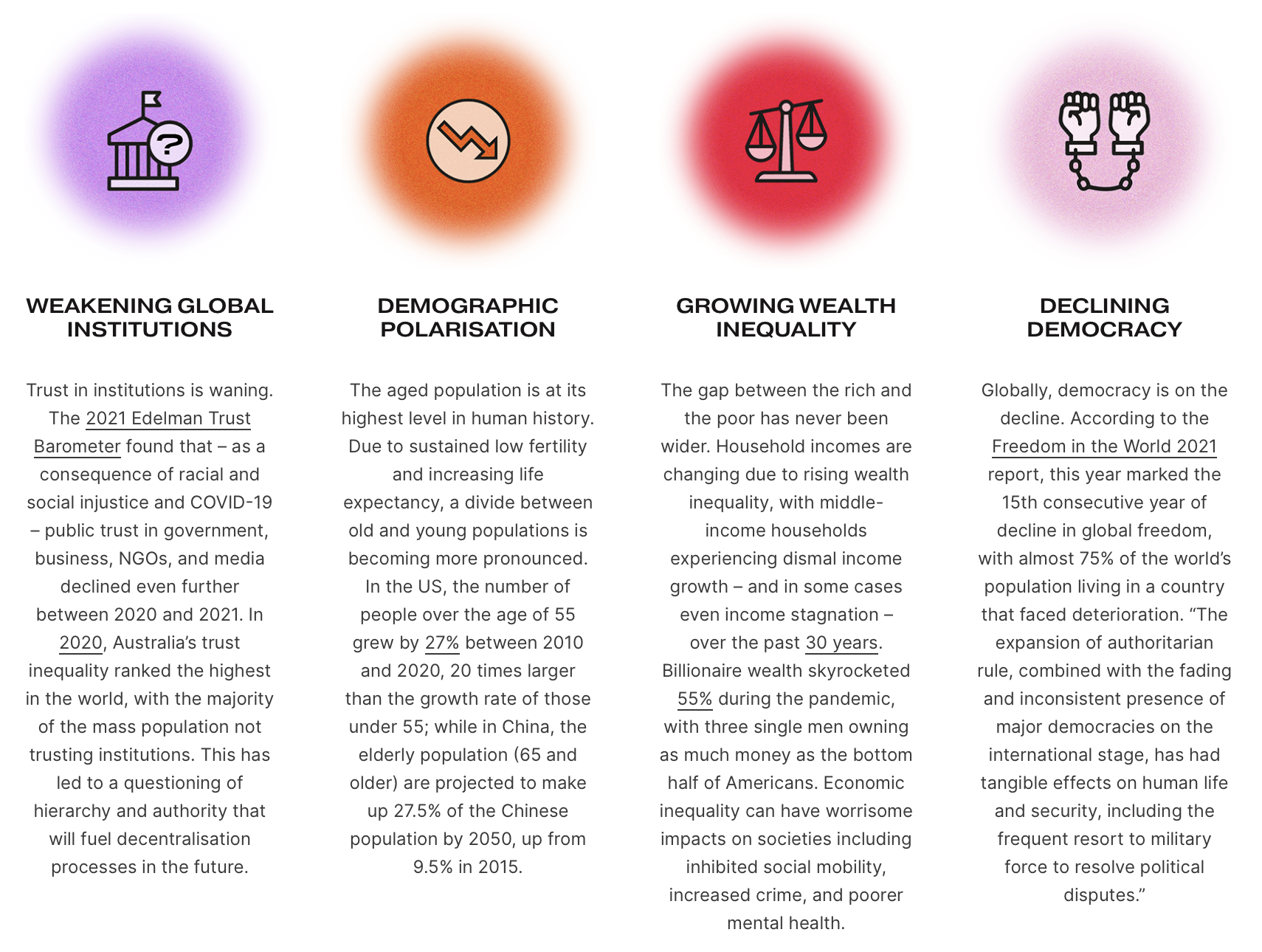
GenZ get real
Instagram Trend Talk 2024 explores Gen Z’s take on trends that will drive global culture in the year ahead. It starts by saying 2023 was a year on socials to remember. From Barbie-core painting the world pink, to the rise of the ‘girl dinner’, viral moments and trends on Instagram and beyond have been driving global culture and influencing Gen Z’s next move.
- Gen Z is all about prioritizing meaningful connections in 2024, with the generation planning to use social media to keep up with their friends and family. A close second was to stay on top of trends (Fashion, Music, Tech)
- When asked how they use their Instagram to get closer to someone, the top ways were: liking someone’s story, sending reels or memes in DMs, and liking a post on their feed.
2024 is going to be defined as Gen Z’s growth era, with many honing in on self improvement and development. Gen Z’s top eras for 2024:
- #1 Self Improvement or Development
- #2 Lucky
- #3 Unapologetically Myself

TikTok’s “What’s Next” 2024 Trend Report for brand owners says that in 2024, the TikTok community will ignite a transformative mindset: Creative Bravery. Fueled by a blend of curiosity, imagination, vulnerability and courage, brands demonstrating Creative Bravery on TikTok will build deeper community connections. Breaking through on TikTok means shifting from occasional displays of Creative Bravery to infusing it into their daily behavior and strategies. Brands that will see most success will regularly pique global curiosities, flip traditional story arcs, and deepen trust with their audiences.
- Curiosity Peaked: Users come to TikTok looking for far more than a single ‘right answer.’ Here, your every curiosity reaches its ‘peak’ with new interests leading to relevant perspectives, uncharted rabbit holes, and IRL action thanks to the perfect blend of passive discovery and an active mindset.
- Storytelling Unhinged: Ends of stories are starting first. Multiple story arcs can happen at once. Communities are making up fictional celebrities and narratives. On TikTok, the shift where everyone can have a voice has unleashed creativity for all, where diverse voices, collaborative formats, and subject matters are flipping everything we know about traditional storytelling on its head.
- Bridging the Trust Gap: There continues to be a growing trust gap between consumers and brands igniting audiences to seek beyond the engagement of a one-time sale. They’re also looking for brands to lead positive societal change and transparency. Establishing clear brand trust and values are non-negotiables. On TikTok, brands have an open line of communication with their consumers and community, and can leverage creators as shortcuts. Each campaign and organic piece of content is an opportunity to share, listen, and learn, building brand trust and values together to generate deeper loyalty on and off-platform.
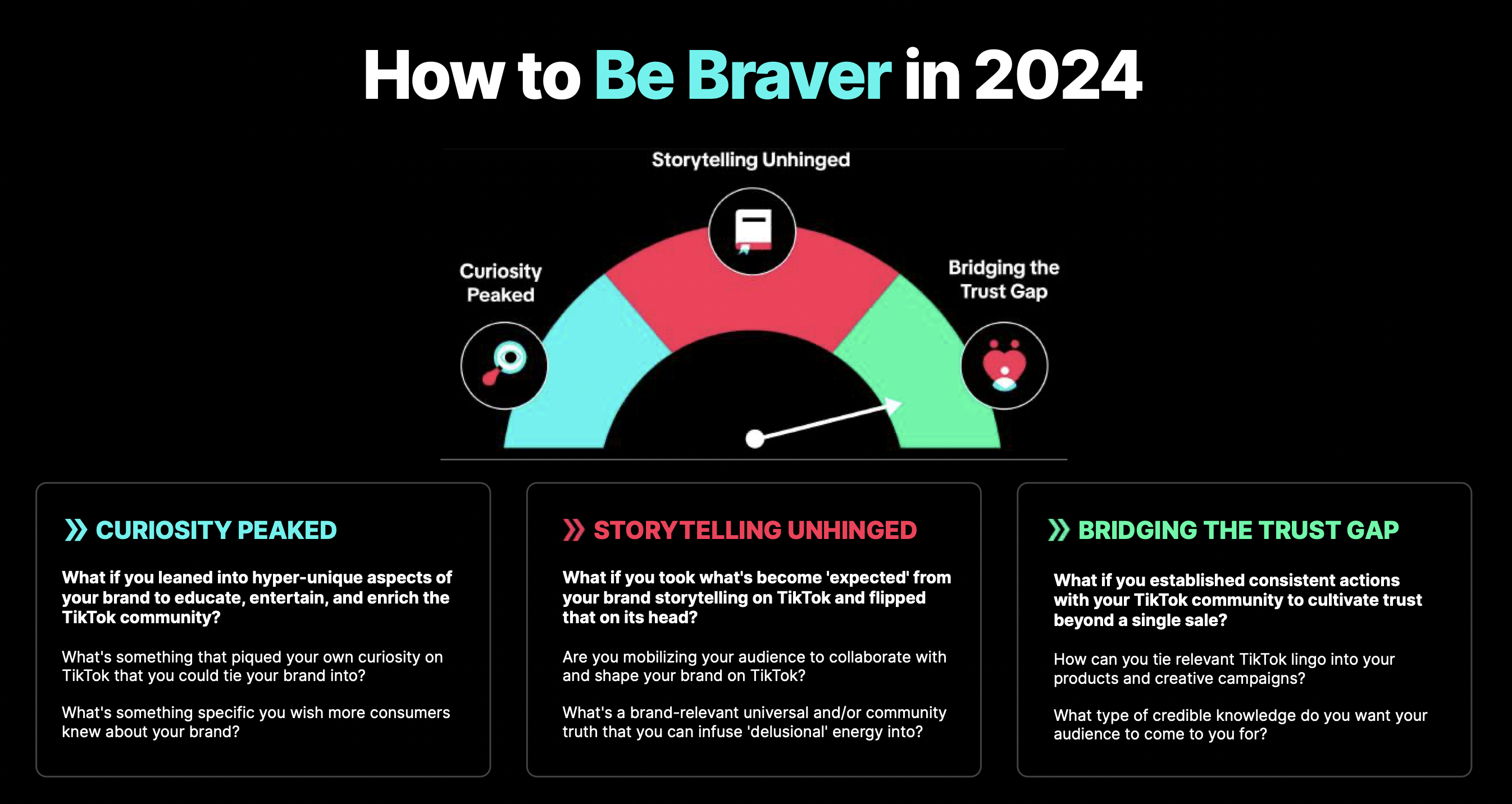
Tech hype and AI, phages and omics
Generative AI has stolen all of the air space in technology over the last year.
Future Today Institute led by Amy Webb always produces great insights into the emerging tech world, although her Tech Trends 2024 report tends to arrive mid year. Following a year, 2023, of breakneck innovation and global upheaval, she sees 10 key themes for 2024:
- Concept-to-concrete AI unleashes a wave of innovation.
- The crypto winter begins.
- Making sustainability sustainable.
- Algorithms are our labor force, and they may need professional licenses.
- Wearables are back. They will usher in a new era of visual and voice answers.
- Organiod intelligence will shape both computing and geopolitics.
- Legal challenges are coming for big tech again––and could succeed this time.
- Biotech accidentally creates a new genetic caste system.
- A world of new materials.
- Elections and unintentional misinformation.
Gartner is a tech advisor who maps what is hot, and what actually works. Their Top 10 Strategic Technology Trendsfor 2024 have a strong AI focus, with:
- Democratised generative AI
- AI trust, risk and security management.
- AI-augmented development.
- Intelligent applications.
- Augmented-connected workforce.
- Machine customers.
- Continuous threat exposure management.
- Sustainable technology.
- Platform engineering.
- Industry cloud platforms.
World Economic Forum has a more interesting report, the Top 10 Emerging Technologies, based on a huge global network of tech experts. The 10 technologies go far beyond AI hype, and are
- Flexible batteries: powering wearable technologies for healthcare and e-textiles.
- Generative artificial intelligence: expanding the boundaries of human endeavour.
- Sustainable aviation fuel: moving the aviation industry towards net-zero carbon emissions
- Designer phages: engineering viruses to augment human, animal and plant health
- Metaverse for mental health: shared virtual spaces to improve mental health
- Wearable plant sensors: revolutionising agricultural data collection to feed the world
- Spatial omics: molecular-level mapping of biological processes to unlock life’s mysteries.
- Flexible neural electronics: better engineered circuits to interface with the nervous system
- Sustainable computing: designing and implementing net-zero-energy data centres.
- AI-facilitated healthcare: new technologies to improve the efficiency of healthcare systems
Expectation Economy
TrendWatching’s Trend Check 2024explores how the Expectation Economy is giving way to the Exchange Economy, an age requiring brands to work together to tackle the world’s toughest and most urgent problems. Over the last decade or so, this has been driven by two financial crises, a pandemic, countless climate-related disasters and deepening geopolitical tensions have, and will continue to, fundamentally alter the landscape. Trends include:
- Sustainability on display: As the beauty sector’s not-so-pretty eco-reality — from deforestation to growing emissions — is uncovered, 50% of millennials globally and 45% of gen Z are prepared to drop personal care brands that fall short of their responsibility to the Earth. Example: Asket’s receipts itemize the environmental cost of every clothing purchase.
- Code it yourself: Ever since the generative AI boom, conversations about tech have dominated public discourse. The adoption of LLMs and text-to-anything software created a newfound willingness to play and experiment, giving rise to a code it yourself mindset, with new tools enable consumer-led personalization. Example: BlueSky is a social media platform that lets users choose their own algorithm
- Common Tongue: Reconnecting a divided world through entertainment. For entertainment brands who want to captivate diverse audiences, taking a definitive stance risks alienating audiences and inadvertently deepening polarized societies. Example: SOS AMAZÔNIA is a Fortnite game teaches gamers to protect Indigenous land.
- BrandCare: Fashion brands take a more active role in caring for consumers’ health. Across the globe, pandemic-struck healthcare services still remain under pressure. As a result, care demands outweigh supply, pushing consumers to look elsewhere for ways to optimize their wellbeing. Example: Morrisons and NHS: UK supermarket puts cancer awareness messaging on underwear labels.
- Future Proofed: Building financial literacy in a complex economic context. As the world grapples with widening economic disparities, record debt and a lack of affordable housing, there’s a clamour for financial literacy. Example: Brazil-based financial platform Nubank has introduced its version of the classic board game Game of Life.
- Eco-Boosters: Sustenance that gives back to nature. A new wave of food and beverage consumers don’t want to just ‘cause less harm’, they want to go further, returning more to nature than they take. Example: London brewery Gipsy Hill release an offset-free, carbon-negative beer.
Future Shock
WGSN’s Future Consumer 2024 report starts with Alvin Toffler, author of Future Shock, who said “In the past, you made a decision and that was it. Now, you make a decision and you say, ‘What happens next?’ There’s always a next”.
Coined by futurist Alvin Toffler and Adelaide Farrell in their 1970 book of the same name, Future Shock refers to the social and emotional paralysis induced by the “shattering stress and disorientation” at the magnitude and velocity of the changes we are experiencing.
In 2024 we will see the dawn of the Everything Net – a circular existence where lines between physical and digital worlds are blurred. There is great promise in the meta-economies that will arise from this, but rapid technological change that affects daily life always induces a sense of anxiety. This uneasiness has a name: Future Shock.
The pandemic exacerbated these sentiments, and the subsequent war in Ukraine and cost-of-living crisis are only likely to compound these feelings. Disruption to routines, isolation from loved ones and conflation of home and work life all gave rise to chronic multitasking, particularly for those working remotely. A 2021 Microsoft study found that people multitask more frequently in larger and longer video meetings, and in recurring meetings rather than ad hoc ones.
To perform a task, several brain networks dealing with attention and cognitive control are involved. Kevin Madore, a neuroscientist at Stanford University in the US, has proven that attempts to multitask can create interference among these networks and this can lead to slower processing as well as mistakes, creating a chronic circle of stress. Research shows that only 2.5% of people are able to multitask effectively. When we think we are multitasking, we are actually performing individual actions in rapid succession.
Synthetic reality
Canvas8’s Expert Outlookis always one of the most considered sources of new insight, but unfortunately is not published in an easily accessible format. It identifies eight critical challenges that will shape consumer behaviour and brand-consumer relationships in the coming year:
- Global Boiling Point: Living with extreme heat sparks a new climate, culture, or war.
- Economic Polarization: People struggle to maintain control over their finances
- Cultural Detachment: An overload of information makes consumers less committed to products and places.
- Rogue Leaders: Volatile leadership creates a sense of anarchy.
- Anti-human: A sense of human devaluation drives unrest.
- Diversity, Equity, and Inclusion (DE&I): The failure of DE&I initiatives erodes trust.
- Synthetic Reality: Artificial intelligence intensifies cognitive stress and challenges perceptions of truth.
- Cyber Vigilantism: Digital security concerns foster technophobia.
AI excitement
GWI’s Connecting the Dots is another, in an interactive format rather than a report. Some of their big themes to dive into include:
- The media’s got a trust problem: How to rewrite consumers’ relationship with the news. Media organizations should prioritize rebuilding public trust, highlighting the transparency, accuracy, and authenticity of their work.
- AI excitement is rising, but so is concern: Navigating the tension between AI fears and opportunities. AI is set to become a core part of life for humans and businesses. To make the transition as smooth as possible, brands need to address consumers’ red flags.
- Boomers are doing more scrolling and shopping: Why they offer brands bang for their buck. Boomers represent a lucrative and increasingly accessible market, as well as an untapped opportunity for many brands.
- Short-form video is changing sports: How social media’s rewriting the sports playbook. Short-form video is key to drawing in new audiences, and major sports should get in on the action.
- Veganism ain’t so hot anymore: How to make plant-based diets tasty again. Plant-based food’s addressable market is evolving. Food brands should target flexitarians and those interested in reducing their meat consumption, not just vegans.
Greenwashed out
Euromonitor also explores how consumer preferences are closely linked to the sustainability agenda, technological progress and the impact of sociopolitical issues.
- Ask AI: New tools are evolving into co-creators for consumers, influencing their decisions and reshaping their expectations of brand engagement. These platforms will become increasingly integrated into consumers’ daily lives. Businesses should utilise generative AI to enhance personalisation and improve the overall customer experience.
- Delightful Distractions: Consumers seek an escape from daily stress and anxieties to break away from the mundane. Some 29% of consumers would be comfortable with brands tracking their emotions and personalising experiences to their moods.
- Greenwashed Out: While consumers are attempting to live more sustainably, they question whether companies and governments are fully utilising available resources to create a meaningful impact. They want organisations to step up and show proof of their eco pledges.
- Progressively Polarised: Political and social issues are at the core of personal identities. These belief systems influence perspectives, values and attitudes. Consumers will not refrain from expressing their convictions. Social responsibility, political affiliation and sustainability initiatives will motivate spending.
- Value Hackers: With the ongoing cost-of-living crisis consumers are adjusting their financial mindset and 44% of consumers planned to save more money in 2023. They are employing increasingly clever strategies to get the very best deals.
- Wellness Pragmatists: Consumers are seeking fast and effective solutions to improve both their physical and mental wellbeing. Demonstrated effectiveness will play a significant role in their purchasing decisions.
Social is retail, retail is social
CapGemini‘s “What Matters to Today’s Consumer” Report 2024 finds that consumers are feeling a bit more optimistic than last year, despite the continued higher cost of living, and economic uncertainty. The report also explores attitudes to AI saying that consumers are generally positive about the benefits it can bring to their experiences.
- 66% of users welcome product recommendations from generative AI
- 60% trust services and products suggested by generative
- 55% seek advice in areas such as diet plans, make-up suggestions, and fashion combinations from a generative AI tool.
- 58% say generative AI should be able to identify their brand and product loyalty, thereby recommending similar products.
The reports main focus is on social commerce – or live commerce – with the increasing fusion of social to retail, and retail to social.
Social commerce refers to shopping experiences that occur directly on a social media platform, including clicking a link on a social network that leads to a retailer’s product page with an immediate purchase option.
- 25% of consumers have bought a product via a social media platform: 41% of consumers from Spain; 30% from the US; and 28% from Sweden. More purchases are made by households with children (36%) than households without children (17%).
- 46% of Gen Z consumers surveyed have made a purchase on a social media platform in the past year. Almost 48% of US Gen Z (aged 18‒29) say they will do at least some of their year-end shopping on social media platforms such as TikTok or Instagram.
- Instagram (62%) and YouTube (62%) are the preferred purchasing platforms across generations of consumers, followed by Facebook (55%) and TikTok (44%). Gen Z consumers show a strong preference for Instagram (70%), TikTok (63%), and YouTube (58%) for their purchases, whereas Millennials primarily prefer to use Instagram (67%) and YouTube (63%)
- The most strongly preferred platforms for Gen X and Boomer consumers are YouTube,Instagram, and Facebook.
Never Normal
Nexxworks “Look Up!” 2024 Trends Report starts with “We have arrived in the Never Normal, an era of accelerated change and enhanced complexity where companies will need to behave differently if they want to survive.
A beautiful example of our times was the OpenAI saga where Sam Altman was ousted from his own company. Then a lot of things happened, after which he came back triumphantly, and ironically with more power than ever. Fun fact: I was in the process of editing this document when I changed Sam’s title to ex-CEO only to undo that change the very next day. That was peak 2023 behavior.”
Conway’s Law states that organizations will design systems that copy their (communication) structure. This OpenAI soap seems to prove that it works the other way around, too: that a system – in this case, the fast and furious LLMs which are overconfident, have limited context understanding and lack explainability and common sense – can apparently also influence how an organization handles situations.
The only real recurring themes they see are the drivers of this enhanced unpredictability:
- The Great Depression 2.0: people are struggling financially and mentally, and companies are adapting to that, some better than others.
- Climate change: (people and) companies no longer have the luxury of ignoring the harsh truth of climate change, because they are starting to feel its direct impact.
- The Age Of Generative AI: rarely have I experienced such an acceleration of technology as with generative AI and we’re probably just at the very beginning.
- A Quantum World: on a perhaps more philosophical level, the real world is increasingly demonstrating quantum characteristics like entanglement and superposition and that is making it even more complex and unpredictable. It’s like having our own personal never- ending feedback loop but make it quantum.
“So basically, it’s we, humans of planet earth, who are creating this Never Normal. We have created a geopolitical, capitalist and resource environment that is so entangled and volatile that wars on one end of the world fuel energy and food crises in the other.”
Moments of Joy
Dentsu’s Creative Trends Report 2024 explores the power of hope in a volatile world. At a time where the future has perhaps never felt so uncertain, “The Futures Less Travelled’ urges brands and business to seize the moment to design, innovate and strive for the future they want to see.
Yasuharu Sasaki, Global Chief Creative Officer at Dentsu Creative, said: “Against the backdrop of this uncertain world our report turns to hope as a deliberate choice, to empower us to take control and design our own futures. Through creativity, armed with the powers of technology and storytelling, we hold potential to pave ways for many exciting ‘Futures Less Travelled’, borne of core principles of optimism and ambition”.
The report unpacks five macro trends for 2024 and beyond, each with a number of sub trends to explore. Each trend uncovers unexpected possibilities, such as the power of joy in the face of anxiety, the potency of storytelling as a force for change or the potential of deep local insight to connect diverse communities around the world.
- Ode to Joy: In a world where joy can seem in short supply, it becomes more important than ever. As we look around at the close of 2023, we see joy, softness and play emerging as protection against a chaotic and volatile world.
- Joyful Resistance Moments of joyful surrealism emerge in response to a world in chaos, while advertising rediscovers the transformative power of humour.
- Self-Care as Subversion Be it the refuge of an “Everything Shower”, or the rise of the “soft life” and “lazy girl jobs” in rejection of hustle culture, a quiet rebellion against the fast-paced, high pressure, lifestyle is underway.
- Unadulterated Play Adult responsibilities are unattainable or being deferred in favour of play, as seen in the boom in “Kidult” toys, the popularity of a basic #GirlDinner or a new wave of experiences that merge art galleries and soft play.
- The Memes of Production: In a related trend, we see creators reclaiming genres and formats easily underestimated as soft, superficial or trivial as forces for change.
- From world-building to building better worlds A generation raised on world-building and co-creation are taking those skills and expectations with them into adulthood, with heightened expectations of agency and empowerment.
- Change the story, change the future Broadcasters and curators are embracing storytelling over factual content to help audiences digest the complexity of our times, recognising the power of new narratives to unlock new possibilities.
- The meme-ing of life Like parables or cartoons before them, memes and reels have emerged as a way of distilling complex ideas or scathing commentary into brilliantly bite-sized, shareable and endlessly repeatable formats. Be it #Fintok, #Cleantok or social justice, no topic is too complex to go viral.
- Here we are now: Perhaps in response to a world that can feel overwhelming, perhaps in response to a cost of living crisis, we see a powerful engagement with all things local and homegrown
- Empathy in Action Personal truth is a new imperative, seen in the rising popularity of neighbourhood media and the growing importance of indigenous populations in shaping a new and more equitable travel industry.
- Local Luxury The post-pandemic world relies less on international networks, with an increased appreciation for goods and services closer to home that draw on local traditions and iconography.
- The Cosy Web A desire for a more rooted sense of place in the world is also being reinforced in the digital space. The idea of the ‘cozy web’ is replacing vast social platforms as a safe space for more intimate online conversations.
- The Magic in the Machine: As AI both impresses and perturbs, perhaps in equal measure, we ask ourselves, what is the role of technology in augmenting our humanity? How can technology unlock imagination and shape new experiences that bridge physical and virtual world?
- AImagination With ChatGPT emerging as the fastest growing app in history, we will see not only unfettered imagination but more practical and scaleable use cases designed to enhance the customer experience.
- In Touch with Humanity Despite exponential leaps forward in artificial intelligence, we see enduring power in experiences that connect technology and humanity through touch, haptics, voice, gesture and beyond.
- Borderless Commerce Technologies such as Augmented Reality, Image Recognition and virtual worlds are blurring the boundaries between online and offline commerce beyond all recognition.
- Me, Myself, and Us: Changing demographics prompt us to re-evaluate our relationship with the communities and collectives that define us, while the emergence of “digital twins” poses fascinating questions about identty and autonomy.
- The “I” in Collective Traditionally individualist Western culture is opening up to a more collective existence, while in contrast, traditionally more collective cultures are exploring a new sense of individuality.
- My (Inter)generations An increase in intergenerational living is giving rise to a reappraisal and appreciation of the older generation, demonstrated through an increase in fashion brands engaging mature ambassadors and the enduring popularity of the #grandmillennial trend.
- Digital Doppelgangers The rise and rise of AI also prompts us to explore the nature of our own identity, as artists, gamers and time poor individuals explore the potential of digital doppelgangers to act on their behalf.
Finding hope
Finally Marian Salzman entitles her latest report “Trends for 2024: On Hope’s Edge.” In a world that can seem oppressively bleak, I hope it sparks a bit of optimism, and renewed resolve:
Dear future,
Hope you are well; you aren’t what you used to be.
There is no doubt we are standing on a precipice.
Living in a time of poly-crisis.
Climate change. Culture wars. Paralyzing polarization.
Info wars. Authoritarianism. Military conflict. Economic fragility. Inequity. Disinformation. Disconnection. Bubbles. Hate. And now, with AI, the future is coming so fast that it’s impossible to take in.
Like lampposts that light up a path, trends have helped me make sense of what the future could look like. Throughout my career, I’ve laid out scenarios of probable, predictable, and preferable futures and looked at the data of human behavior and culture to make connections where others had not. But now, I find myself wondering: Are humans still in charge? Or will the unseen hand of AI erode our free will, leading us to do things, buy things, think things without us even detecting any external influence?
With AI, the future is coming faster or, to quote futurist Ray Kurzweil, is “nearer than near.”
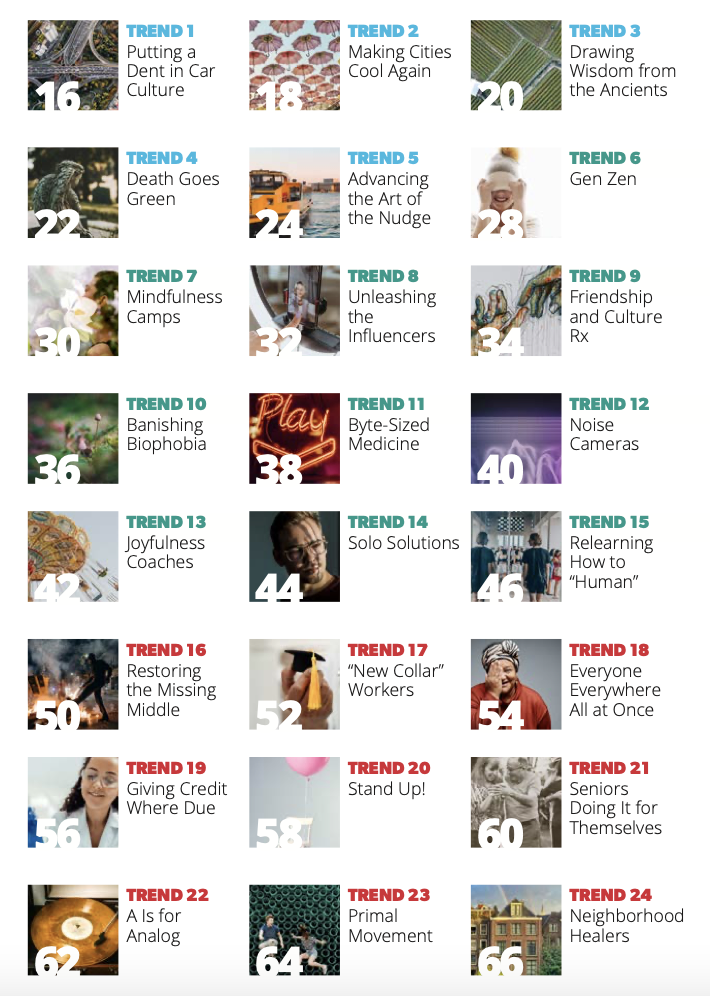
Prediction consensus
Bringing this all together, based on over 700 reports, Visual Capitalist summarised what it saw as the major moments and trends for 2024:
- The S&P 500 makes new all-time highs
- Robotic workers loom over labor
- There will be an Al deepfake election scandal
- Heightened global migration flows
- Bonds are back! (for real this time)
- TikTok leads social media e-commerce
- The U.S. avoids recession again
- 2024 breaks heat records
- Inflation stays cool around target levels
- Lots of lawsuits and regulation around Al
- Japanese markets offer opportunity
- Russia-Ukraine and Israel-Hamas wars won’t end
- Increased geopolitical risk
- GLP-1 (weight loss drugs)become commonplace
- Manufacturing keeps shifting away from China
- First interest rate cut by mid-year
- Apple launches Al in its products
- Diversified portfolios are back in favor
- De-dollarization efforts continue slowly
- 2.5% to 3% global GDP growth
- U.S. tech and chip limits on China intensify
- Hollywood’s influence continues to wane
- India outpaces China in GDP growth
- Generative Al’s next wave is text-to-video
- Marine shipping faces more volatility
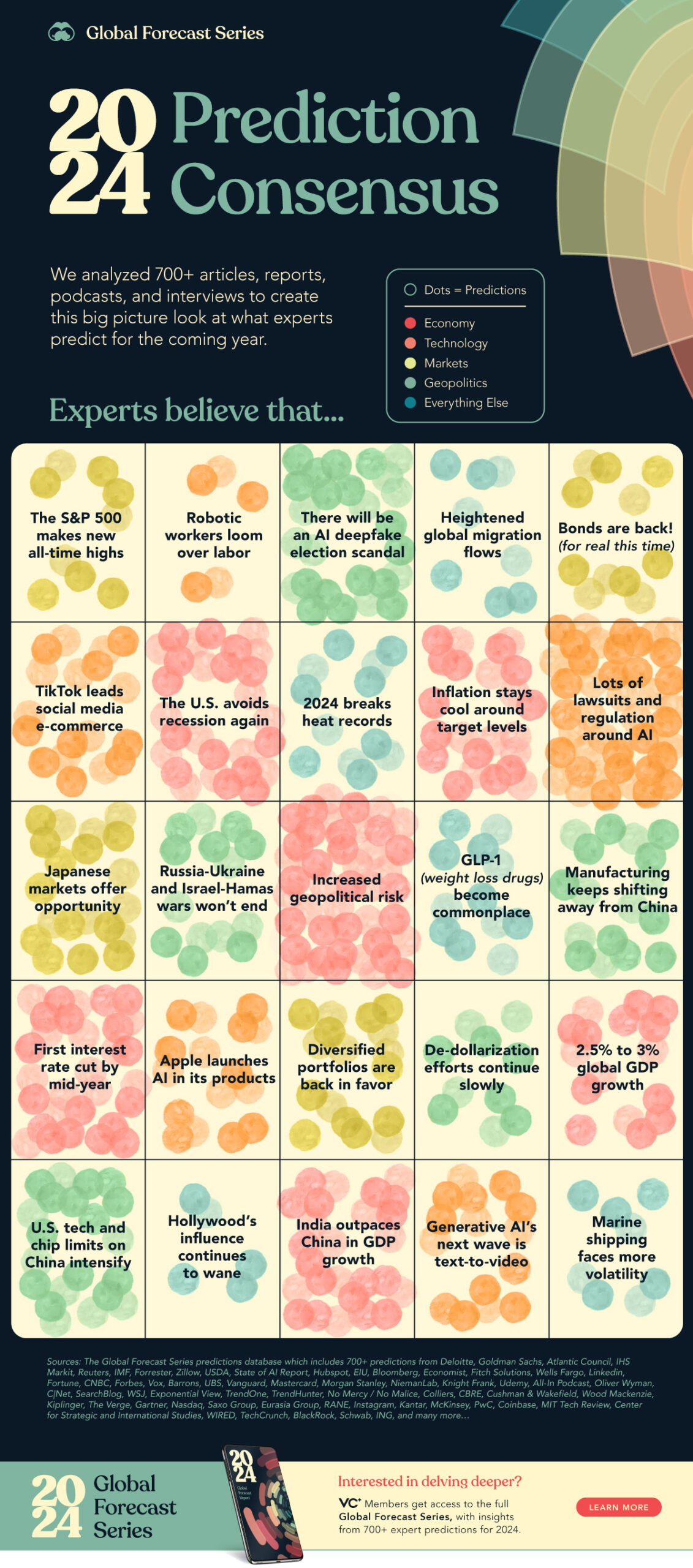
Explore more from Peter Fisk …
- Next Agenda of best ideas and priorities for business
- Business Futures Project collating all the best ideas
- Megatrends 2030 in a world accelerated by pandemic
- 49 Codes to help you develop a better business future
- 250 companies innovators shaking up the world
- 100 leaders with the courage to shape a better future
- Education that is innovative, issue-driven, action-driving
- Consulting that is collaborative, strategic and innovative
- Speaking that is inspiring, topical, engaging and actionable

Davos 2024. Trust was on the lips of every participant.
Three years of increasing division, heightened hostility and a surge in conflicts have created a challenging global landscape. Humanity is grappling with a converging multitude of crisis and change, the need to reinvigorate economies, respond to the threat of climate change, and ensure AI is used as a force for good.
Trust comes in many forms. Trust in authority – from global institutions to governments, scientists and technologists, businesses and brands. Trust in each other. Ultimately we trust in people. Do we accept them? Do we believe them? Do we follow them? Are they authentic? Are they worthy? Are they right?
The World Economic Forum’s theme was in particular focused on our trust in the future.
“After an era that lifted a billion people out of poverty and improved living standards everywhere, the anxiety about losing control over what lies ahead is pushing people towards embracing extreme ideologies and the leaders who champion them.”
Rebuilding trust in our future is paramount. We can only trust in the future, if we trust in people. In institutions. And from an economic perspective, in business.
The Trust Paradox
Rapid innovation offers the promise of a new era of prosperity, but instead risks exacerbating trust issues, leading to further societal instability and political polarisation.
This is the paradox explored in the 2024 Edelman Trust Barometer.
“In a year where half the global population can vote in new leaders, the acceptance of innovation is essential to the success of our society. While people agree that scientists are essential to the acceptance of innovation, many are concerned that politics has too much influence on science. This perception is contributing to the decline of trust in the institutions responsible for steering us through change and towards a more prosperous future.”
Only one third of consumers trust most of the brands they buy or use, according to an Edelman special report.
According to the survey of 16,000 people in eight countries, 81% of consumers see brand trust is a deal breaker or a deciding factor when they consider a purchase. Trust is becoming more important because of growing concerns about the fast pace of innovation and automation, the use of personal data in tracking and targeting, and the impact of products and productions on society and the environment.
“Trust has always played an important role in brand purchase” says Richard Edelman, CEO of Edelman. “But consumers now have much larger expectations of brands, and their trust is predicated on how well a brand can pass through the three gates of trust – product, customer experience and impact on society.”
When brands build trust, consumers reward them. Consumers who trust a brand are more than twice as likely to be the first to buy the brand’s new products, to stay loyal in the face of new competition, to recommend it, and defend it when things go wrong. Also, a brand trusted because of its broader role in society, is almost twice as likely to gain such support, than if it’s trust is due to product aspects only.
Despite all of this evidence, brands are increasingly untrusted.
Most consumers believe that a brand has a responsibility to get involved in at least one social issue that does not directly impact its business, yet few see brands doing so. Indeed, most people think brands are using social good as a marketing tool, “trustwashing” if you like. This exasperates their loss of trust.
However people’s trust in governments and other institutions is far less than in business, meaning that whilst many are unsure, they do see business as a better platform for addressing social and environmental issues than politicians and their agencies. Interestingly, people believe they have more influence on business than governments and can persuade them to take these issues more seriously.
“It’s time for brands to take the next giant step,” says Edelman. “They must accept the responsibility consumers have given them to effect change and welcome greater accountability and measurement of their impact.”
Building trust with authenticity
We engage more emotionally, human and empathetic, than every before. In fact people trust each other more than any business, they influence and are loyal to each other.
25 years ago, Ray Davis arrived in the small Oregon town of Roseburg, where nothing much changed for the lumberjacks of the huge surrounding forests. His task was to transform the sleepy old South Umpqua State Bank with its 40 employees before it died.
Initially people poked fun at his insistence that employees, or colleagues as he called them, answer the phone with a cheery “Welcome to the World’s Greatest Bank.” However, over time, it became true. The bank was transformed, firstly by learning from other great customer service businesses, not banks. Banks become community hubs, interiors were opened up and modernised, products and language humanised. They served coffee, played music, and showcased great local businesses. Staff smiled, and customers loved it. Nowadays, Umpqua Bank, with over $25 billion assets and 350 branches across America, is one of the best banks.
However, Davis, now enjoying his retirement, or in “cruise” mode, as Umpqua calls it for customers who wanted to slow down and enjoy life, has a warning about change. “When we arrived in Roseburg, change was exciting, people loved progress. Today change is different, it has become relentless and dominated by technology. It scares the hell out of a lot of people” he warns. As change accelerates, and technology dominates, many people lose faith in progress. The bond of trust can be lost.
Being real, authentic and transparent
In her book Who Can You Trust? Rachel Botsman asks “If you can’t trust those in charge, who can you trust? From government to business, banks to media, trust in institutions is at an all-time low.” However, she argues that technology can enable trust in new forms, and that our main problem is a mismatch, saying “institutional trust was not designed for the digital age.”
Originally trust was built locally between people, in local communities. Then as cities and business grew, we deferred to institutions as curators of trust – governments and corporations – trusting them to act on our behalf. Trust went from people, to being built around hierarchies. Today, trust is built in networks, and flows between people enabled by technology. For a business there are three layers of trust:
- Trust in the organisation: the reputation of the business and brand, particularly in terms of ethics and responsibilities, openness and transparency.
- Trust in the concept: the relevance to customers, authentic and reliable, a positive way to solve a problem, and delivers on every promise.
- Trust in the people: the respect for people who lead the business, and deliver the concept, who are real and authentic, empathetic and caring.
Authenticity is closely associated with provenance, which is now a source of transparency for many manufacturers utilising the potential of IOT sensors and blockchain certification. Cult Beauty uses a transparency app to help users of its cosmetics to understand the sources of all products, from oils to colourings. Canada’s Bridgehead Coffee was one of the first to set benchmarks for other in fairtrade and organic certification. Fishpeople can tell you the which boat caught your fish and when. Tiffany & Co. can do the same with diamonds.
Whilst all of these matter, the most important is that people trust people. For most customers, they see two faces of the organisation – the leader who typically appears as the company spokesperson in times of challenge, and the everyday frontline employees who sell and serve customers in stores, on phones, or one to one.
As Botsman says “Most businesses that we interact with are built around money, and money only goes so far. Money is the currency of transactions. Trust is the currency of interactions.”
Trusted leaders
Another clue might lie in the new Brand Guardianship Index 2024 produced by Brand Finance. This takes a numeric perspective on the impact which leaders have made to their organisations over time. Not just financially, although this is one useful metric as a proxy for customer and employee engagement, but through a host of other ESG and related metrics too.
Huateng “Pony” Ma, CEO of Tencent, recognised as world’s leading CEO – or at least “brand guardian”, in the report – for his guardianship of WeChat brand. “His leadership, marked by a steadfast commitment to innovation, user engagement, and trust, has not only propelled Tencent to remarkable heights in the technology sector but has also set a gold standard for CEOs worldwide.”
Under Ma’s leadership, WeChat has become the world’s strongest brand, as measured in the Brand Finance Global 500 Index of brands. Ma has led WeChat to build exceptional brand strength, underpinned by its essential, familiar, and trusted status in China, its dominant market.
People trust people
Satya Nadella, Microsoft’s CEO, provides a model for business engagement with society when he gave his views on corporate responsibility, the pressing need for human oversight of artificial intelligence systems and a succinct description of how Microsoft has earned its social license to operate in many countries around the world.
Nadella says every company is now a technology company and that brings with it a range of responsibilities, particularly in areas such as the ethics of AI, which he seeks to proactively take a lead in. “Technology is going to be so pervasive in our lives, and across all industries, that we’d better have one core currency around it which is trust. Without trust, we are not going to have a long-term business” he said at a recent Envision event.
Indeed, Microsoft has positioned itself as the world’s “good tech” company, whilst Facebook and Alphabet are often seen by regulators and politicians as “bad tech”, given their reluctance to address issues like privacy and fake news.
Leadership of trust, and trust in leaders, drives everything else.
We know that any form of change sparks fear in the human psyche. If not addressed early, proactively and directly, fear of job losses due to automation or globalisation can quickly take hold. In times of crisis, a leader brings urgency and compassion, but if there is not also direction and hope, then people lose confidence, and courage in their own actions.
Employees trust leaders who do what they expect them to do.
This requires an openness of leaders, so that people know what to expect. It means engaging people in the future direction, being honest about the need and implications of change, asking for ideas, and equally challenge, being visible and accessible, and being human.
Externally, there was a time when business leaders would never say anything controversial, when businesses were agnostic to the debates of society. Today, as people trust business more than politicians to show them a way forwards, they seek business leaders to take a stand, to have a point of view.
This can be controversial, a viewpoint means that not everybody will agree, that some of your customers might feel alienated or even reject you. Apple is a strong advocate of diversity and human rights; Starbucks challenged the state on their actions against migrants. Leaders need to step up, to express their view, to fight what they believe is right.
In this way, brands develop a more authentic personality, business adopts a more meaningful role in society, and you gain the respect – and trust – of people.
